Work samples
-
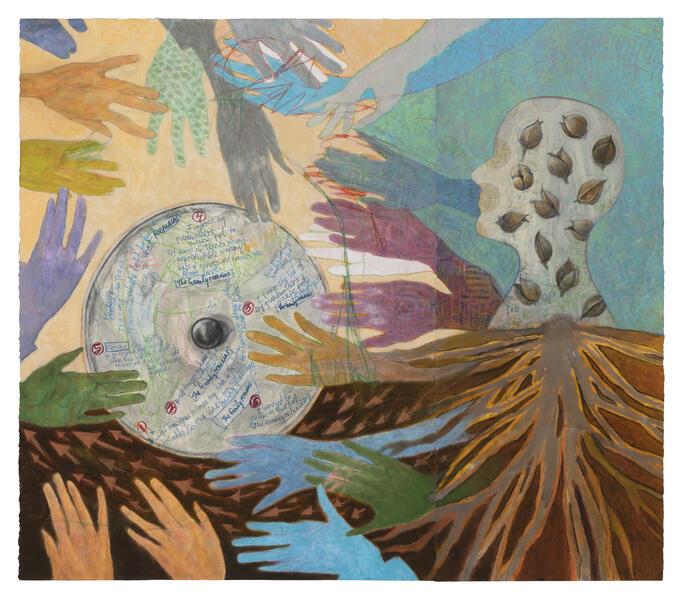 The Family Remains
The Family RemainsAcrylic, marker, graphite and colored pencil on paper, 31.5”x35”, 2024
The Family Remains is a new series (and singular painting) featuring my family’s cooking pot lids as stand-ins for legacy and cultural transmission from 'the old country'. I learned to cook in my maternal grandmother’s sauce pot; then my mother’s sauce and soup pots; later, my father’s soup and stew pots As a helper, particularly with my grandmother, I learned so much more than cooking.
The Backstory: I grew up in a sprawling Italian immigrant family in New York. Though the language, food, idiosyncrasies and traditions were ever present, the pressure to be American, especially from my grandparents’ generation, was palpable. Relatives continued to come from Italy through Ellis Island during my childhood. Italian was spoken by the adults but not permitted by us children. American first, Italian second. With the last of my parents’ generation passing, I consider what remains. These paintings explore the rich stories, lessons and sometimes confusing messages that were my experience.
In this painting, my grandmother's sauce pot lid is the anchor. What happens as family members age and pass.? What remains? The pod-filled head is me, traced by my husband years before he died in 2020. The hands are tracings my son and I made, my hands, when he was little. Our pasts are all woven together to include forever and now.
Available for PurchasePrice on request
-
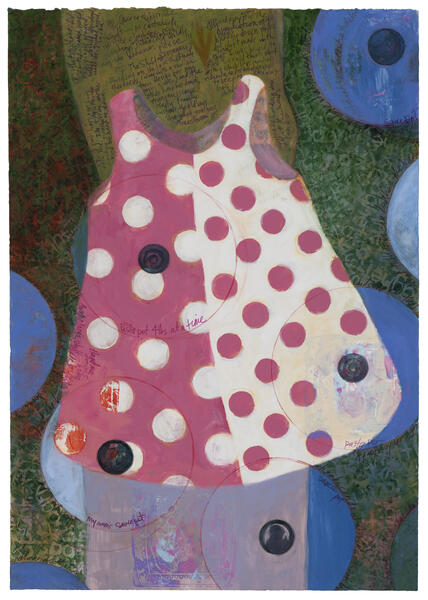 The Shift
The ShiftAcrylic, marker, colored pencil and hand cut stamps on paper
43”x26”, 2024 (This painting is part of The Family Remains series. See below for more information on the series.)The Shift tells the story of a dreadful hot pink and white polka dot dress I was made to wear as a child (my little sister had a matching one) made from fabric that was 'all the rage'. These dresses, also worn by my mother and her sisters, were called shifts. They were inexpensively hand-made by my aunt and passed from older cousins to the younger ones. As an avid tree climber, there was nothing more constraining than wearing a shift. The story of how this came to be my dress is written on the painting along with the emotional shift toward the dress as an adult. My grandmother's and mother's sauce pot lids surround the dress.
The Family Remains is a new series featuring my family’s cooking pot lids as stand-ins for legacy and cultural transmission. I first learned to cook in my maternal grandmother’s sauce pot; then my mother’s sauce and soup pots; later, my father’s soup and stew pots. As a helper, particularly with my grandmother, I learned so much more than cooking.
The Backstory: I grew up in a sprawling Italian immigrant family in New York. Though the language, food, idiosyncrasies and traditions were ever present, the pressure to be American, especially from my grandparents’ generation, was palpable. Relatives continued to come through Ellis Island during my childhood to begin a life here. Italian was spoken by the adults but not permitted by us children. American first, Italian second.
With the last of my parents’ generation passing, I consider what remains. These paintings explore the rich stories, lessons and sometimes confusing messages that were my experience.
Available for PurchasePrice on request
-
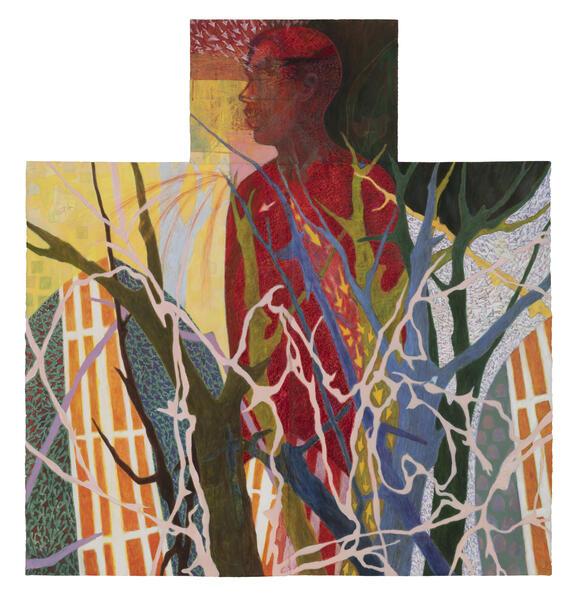 Back Ground
Back Groundacrylic, marker, graphite and colored pencil on paper, 54”x52”, 2024
This large painting tracks my movement back to Baltimore after my husband died in 2020. With the world and myself upended, I took pieces of paper to the road in front of my new place and, in an attempt to reground myself, traced the shadows of an oak tree. The branch outlines are drawn on multiple days with the sun moving the outlines and me dodging cars. I thought of things that moved and flowed with ease: rivers, blood, wind, breath, roots, electricity. I wrote hundreds of words that became the skin of the figure.
I worked on this painting for 3 years and eventually, thankfully, finished it during a 2024 residency at Virginia Center for the Creative Arts.
-
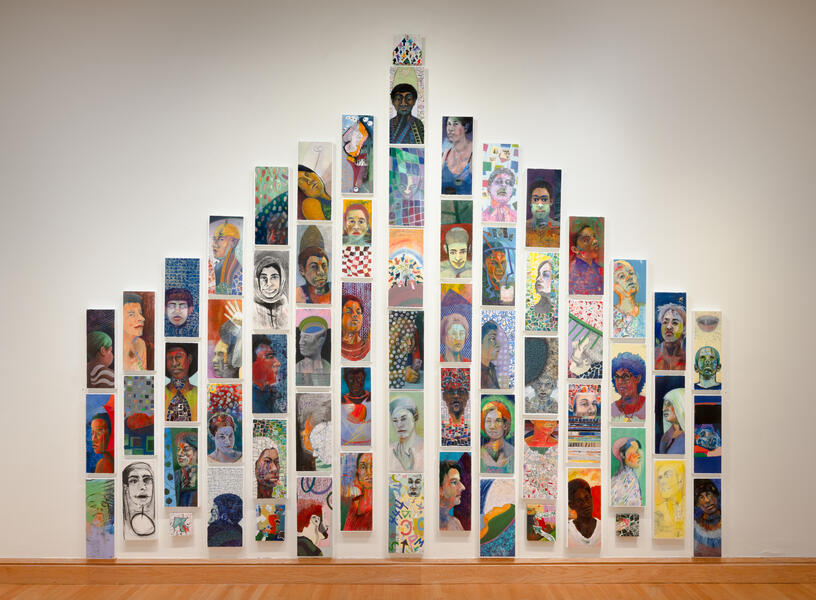 Painted Stories
Painted StoriesPainted Stories is made of 60 mixed media portraits built as a large structure. Most portraits feature real people and each portrait has a story written on the back of the panel. Here's an example of one of the stories: "Another Saturday painting Jenn in her butterfly dress, sitting so calmly, no boys, no noise. I added 'hydrogen', the first element, to Jenn's portrait. Her home life was, from the telling of it, like a time bomb... highly flammable like hydrogen. Somehow, she balanced those realities... the calm, the ticking bomb and the butterfly."
The mixed media panels were influenced by Roman and Egyptian funerary portraits and Catholic icons paintings I saw as a child, The ongoing portrait series, painted over the course of 30 years, was made to honor everyday people. There are over over 300 panels to date.
Available for PurchasePanel sold individually or as a group. Price on request.
About Gina
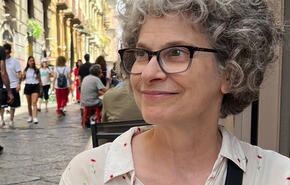
In everything she undertakes, mixed-media artist Gina Pierleoni brings individual elements together to create a more cohesive and loving whole. Most of the series she creates are ongoing and have been in process for decades.
Her portraits on wooden panels (more than 300 to date) feature real people. When installed, they are gathered together as a community or congregation. Old paintings are reworked into larger configurations for the series Human Icons that record… more
Mixed Media Portraits
I use portraiture to spark conversations about empathy and our common humanity. The opposite of assumption, these images attempt to push past label and judgments; they seek to "de-separate" us. My portrait installations feature real people, brought together as a community or congregation.
The portraits are created over weeks, months and years, each lovingly realized. I start with a model, paying close attention to impressions and our conversations. Both form the heart of the piece. My goal is to honor each person.
After our time together, I continue alone recalling as much as possible about the sitter and our time together. The remainder of what happens is intuited. I draw, paint, scratch into, collage. Hand-made stencils and stamps create additional layers. Gender, race and age sometimes blur. Figures emerge from long histories of surfaces and ghosted images. These are real people, alive, changing, vulnerable and genuine.
-
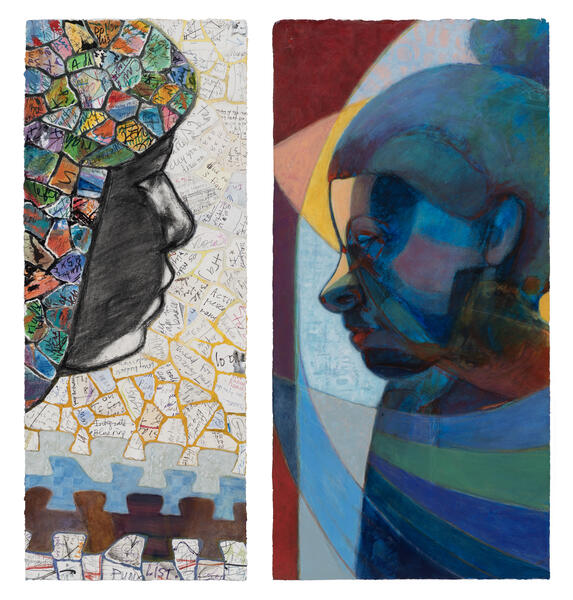 Bevin and Grace
Bevin and Grace -
Gina Pierleoni interview about ongoing portrait series
-
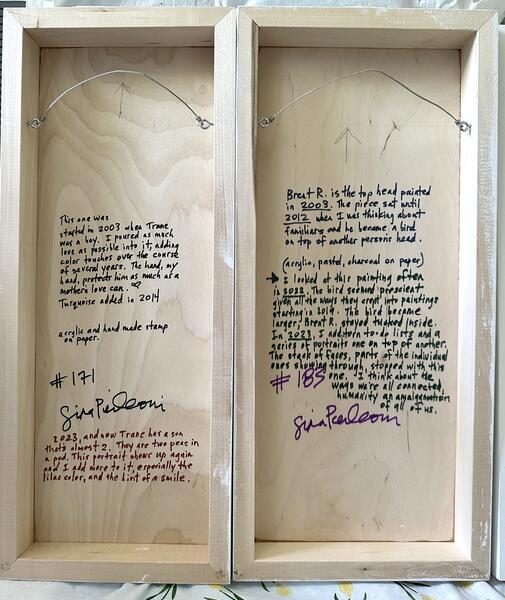 Sample stories on the backs of portraits
Sample stories on the backs of portraits -
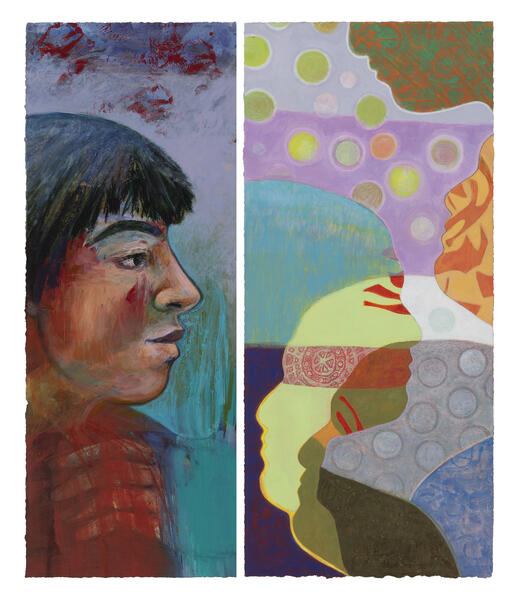 Portraits #171 & #285
Portraits #171 & #285 -
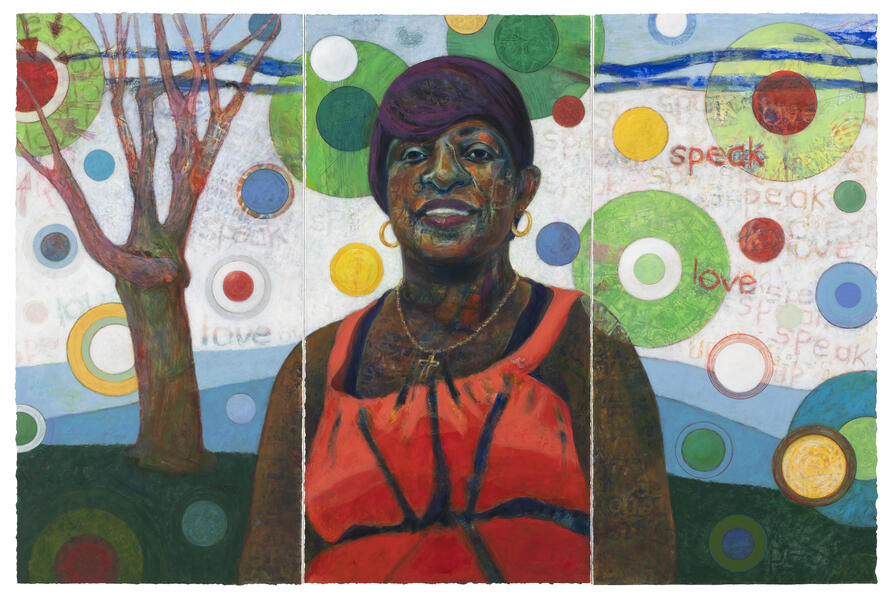 The Elements Speak Love
The Elements Speak LoveThe Elements Speak Love
From the series 'Human Icons'.
acrylic, colored pencil and graphite mounted on 3 wooden panels, 30"x45"
Available for PurchasePrice on request
-
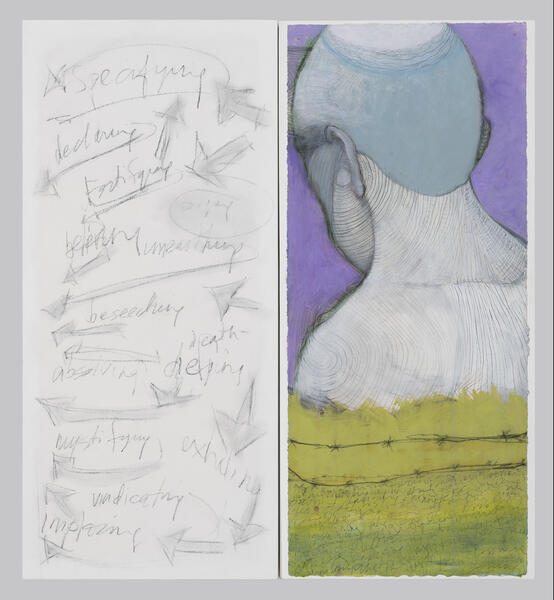 Anything
AnythingBack of Painting
#288 acrylic, charcoal, graphite, ink and colored pencil on paper mounted on wooden panel, 22”x10”x1.5”
This was an enlargement of a sketch done on the Green 6 subway. This person was unaware that I was, in a sense, invading their space. The larger paper was discarded by Layne, a Drawing 2 student whose work was better than she knew. I created the figure from those lines and added more lines to visually represent ways we hold ourselves back. (Hem ourselves in.) Beside are words… becoming, transforming, shaping, morphing, learning, etc… agents of change.
Even more lines were added in 2022. Then this thought:
And the day came when to step forward was much easier than to step back.
Transforming, shaping, morphing, changing, learning, shifting, willing. The answer to ‘how’ is ‘Yes!’
-
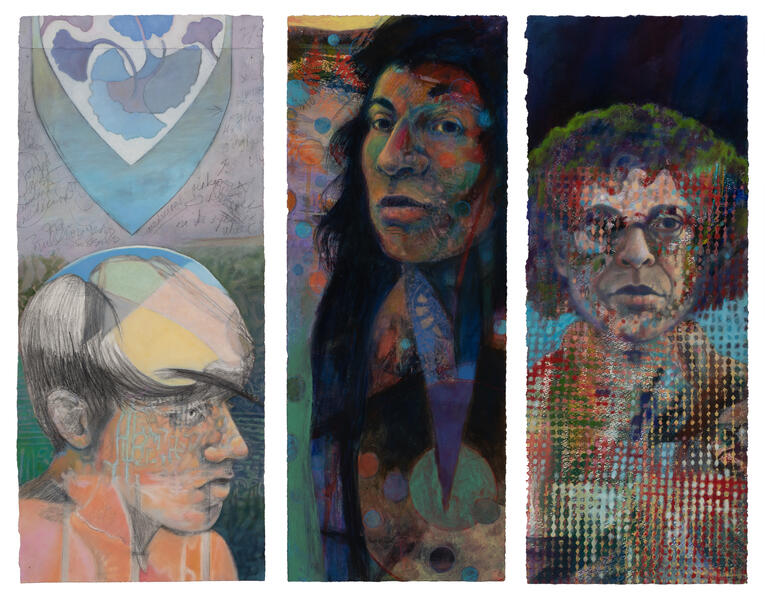 Matthew, Jen and Me
Matthew, Jen and Me -
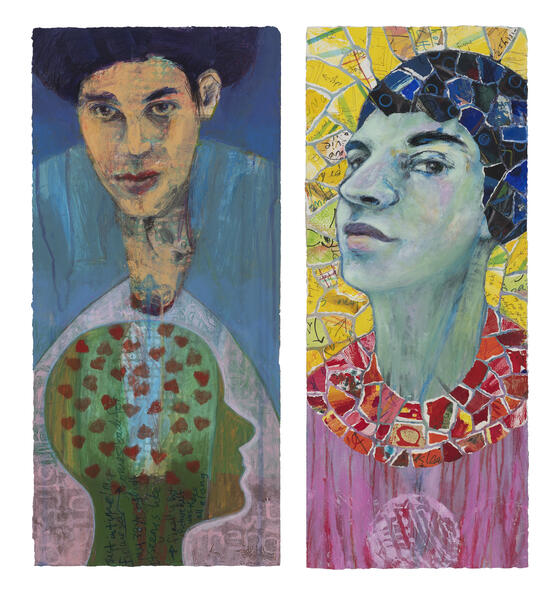 Portraits #315 & #72
Portraits #315 & #72Backs of Paintings
#315 (left) acrylic, pastel, colored pencil, marker and hand-cut stamps on paper mounted on wooden panel, 22”x10”x1.5”
The upper self-portrait was started in the late 1990’s. I could never get it quite right. Just in time my future self (2023) comes back (compassionately so) for my 38-year-old self. It seems like –finally—but future self was there all along.
Consolidating the hard moments of younger life (parenting, working, making art, growing myself) and tucking them into metaphorical pockets for safekeeping, consolidation, self-acceptance.
#72 (right) acrylic, colored pencil, ink, hand cut stamp, torn old paintings and to-do lists on paper mounted on wooden panel, 22"x9"x1.5"
This started as a quick self-portrait in 2000. It focused on the words that sometimes catch in our throats. It was a time of feeling unheard. I was ‘too intense’, ‘overwhelming’. I began to tone myself down as id these were facts.
Almost 20 years later, this piece resurfaced and asked me to engage with it. I glued lots of snippets from conversations I had with myself over the years. I was never overwhelming, nor was I too intense. It turns out, this person listened best to themselves or conversations where they figure prominently. The last part painted was the mouth. During one of our last conversations, I chose to speak just a little and listen a lot. Why? I have a gift for listening and it doesn’t show up when I’m talking.
In 2023, I added a head wrap (one of my grandmothers often wore one) and a collar. The collar came when I was thinking about Ruth Bader Ginsburg and Egyptian royalty. In my world, everything overlaps and everything has a voice.
-
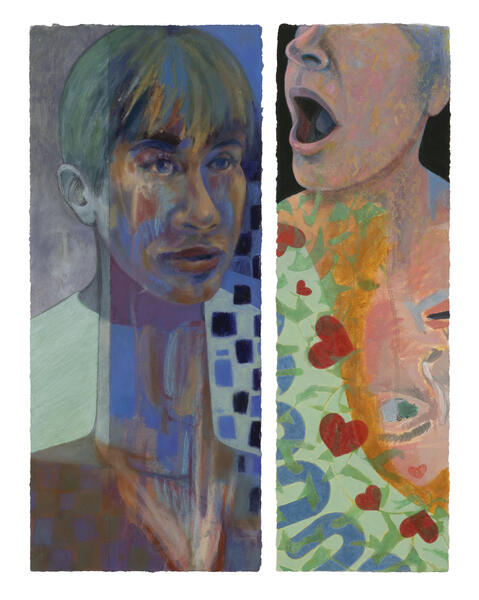 Portraits #142 & #243
Portraits #142 & #243Backs of Paintings
#142 (left) oil, acrylic and graphite on paper mounted on wooden panel, 22"x10"x1.5"
In my years of portrait painting, I have had a surprising number of models named Jen, Jenn and Jenny. This Jenny had magnificent bangs and she was very proud of them. This Jenny also had a quick mind, interested in all kinds of things. I imagined her bangs warmed her thoughts and kept them from spilling over. At one point in reworking this piece, the Madonna with the Long Neck painting was on my mind so I painted Jenny with her neck elongated and the length it was.
2002: Started at Phil’s studio over top of the painting ‘XO’.
2016: Expand to 2 panels. (Left one added.) 2017: Top with oil paint.
2023: More oil paint added, neck lengthened.
#243 (right) acrylic on paper, mounted on wooden panel, 22"x7"x1.5"
A Painting 1 student, Danielle, attempted her first self-portrait and threw it out. I took it out of the trash, tore it, turned it upside down and showed her another way to work it. Painting is like a visual voice so I added my mouth shaped like a heart and her tender heartedness with all the protection it needed… a double portrait and then some.
2008: Started. 2018: Leaves made greener.
2022: Added the colors the student used to my parallel portrait so the two had a deeper relationship. The horse shoes were for her, upright and lucky wherever she is. Parallel paths searching, converging, strengthening.
2023: 6 more hearts were added. More love, speak love. Plenty to share.
-
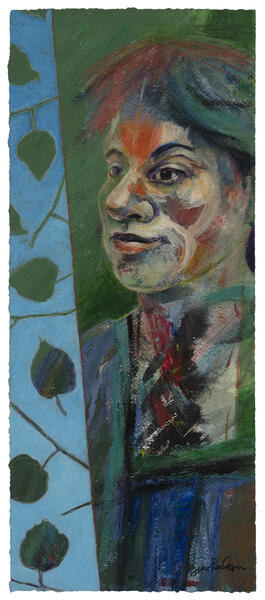 #283 (Pods)
#283 (Pods)acrylic on paper mounted on wooden panel
22"x10"x1.5"
Available for Purchase$950
Mixed Media Portraits and Installations
My mixed media paintings are created over weeks, months and years, each lovingly realized. I start with a model, paying close attention to impressions and our conversations. Both form the heart of the piece. After our time together, I continue alone recalling as much as possible about the sitter and our time together. The remainder of what happens is intuited. I draw, paint, scratch into, collage. Hand-made stencils and stamps create additional layers. Gender, race and age sometimes blur. Figures emerge from long histories of surfaces and ghosted images. These are real people, alive, changing, vulnerable and genuine.
-
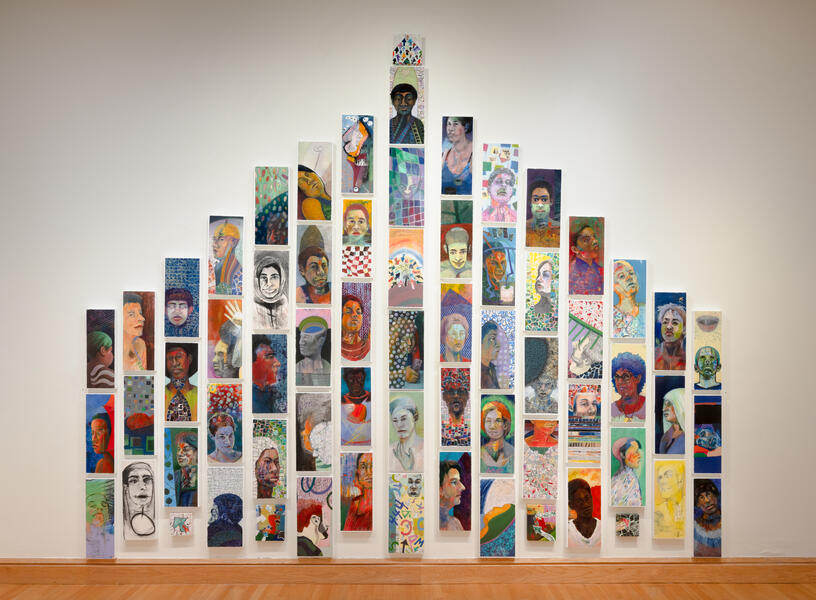 Painted StoriesPainted Stories is 60 mixed media portraits built as a large structure. Most portraits feature real people and each portrait has a story written on the back of the panel. Here's an example of one of the stories: "Another Saturday painting Jenn in her butterfly dress, sitting so calmly, no boys, no noise. I added 'hydrogen', the first element, to Jenn's portrait. Her home life was, from the telling of it, like a time bomb... highly flammable like hydrogen. Somehow, she balanced those realities... the calm, the ticking bomb and the butterfly.
Painted StoriesPainted Stories is 60 mixed media portraits built as a large structure. Most portraits feature real people and each portrait has a story written on the back of the panel. Here's an example of one of the stories: "Another Saturday painting Jenn in her butterfly dress, sitting so calmly, no boys, no noise. I added 'hydrogen', the first element, to Jenn's portrait. Her home life was, from the telling of it, like a time bomb... highly flammable like hydrogen. Somehow, she balanced those realities... the calm, the ticking bomb and the butterfly. -
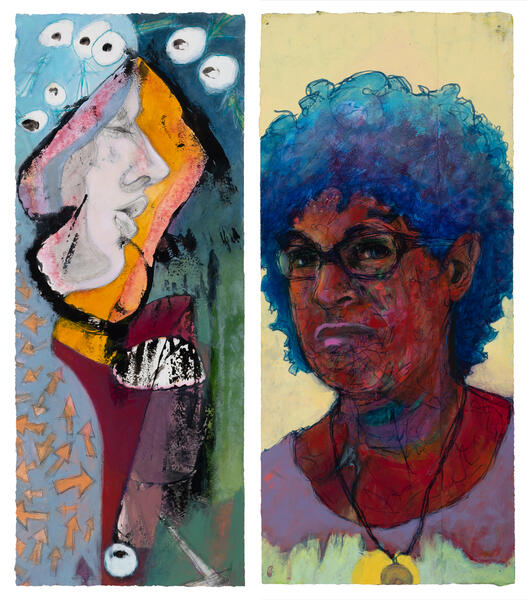 Liz and MeLiz and Me oil, acrylic, ink, marker, colored pencil and graphite on paper 22"x19"
Liz and MeLiz and Me oil, acrylic, ink, marker, colored pencil and graphite on paper 22"x19" -
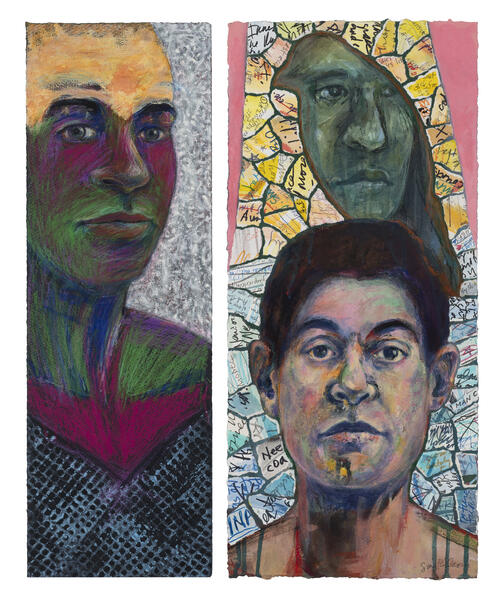 Portraits #155 & #183
Portraits #155 & #183 -
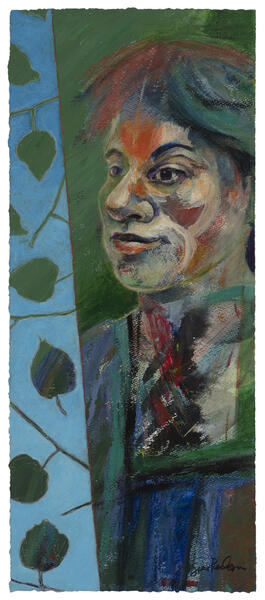 Pods
Pods -
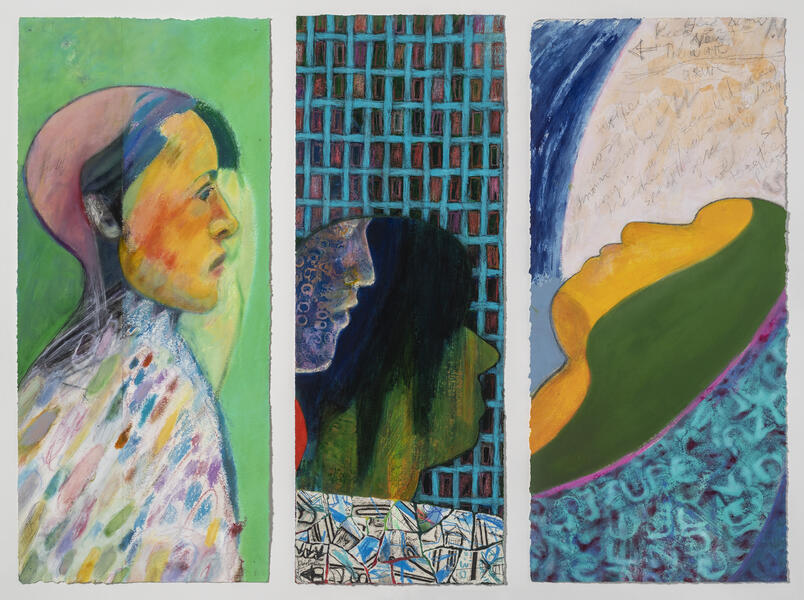 Thea (with Bevin hidden), Gale and Lauraoil, acrylic, colored pencil, graphite, ink and torn paintings on paper approximately 21"x9" each
Thea (with Bevin hidden), Gale and Lauraoil, acrylic, colored pencil, graphite, ink and torn paintings on paper approximately 21"x9" each -
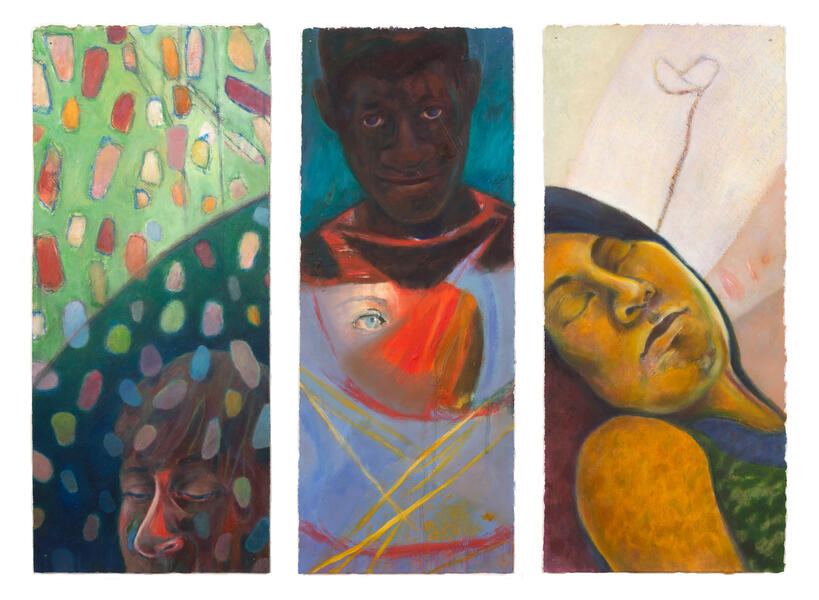 #269, #231 & #280acrylic, oil, ball point pen, graphite on paper Each panel is approximately 22"x9.5"
#269, #231 & #280acrylic, oil, ball point pen, graphite on paper Each panel is approximately 22"x9.5" -
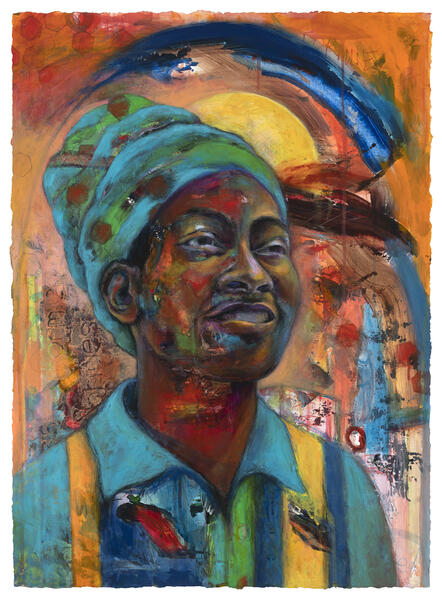 Luminous
LuminousLuminous (Myles)
from the Human Icons series
acrylic, graphite, marker and colored pencil on paper 30"x22"
-
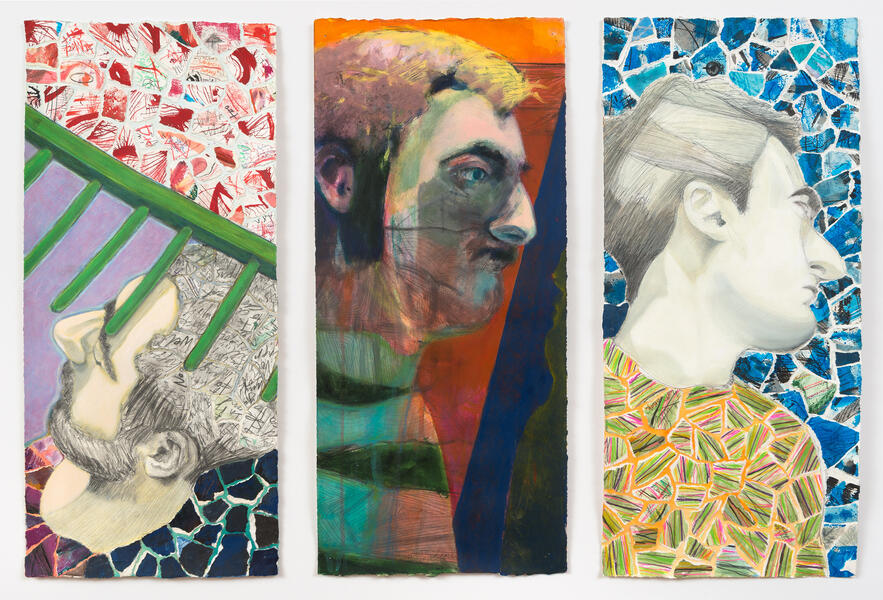 #270, #274 & #264 (all Kyle)acrylic, oil, graphite, ink, colored pencil and torn paintings on paper Each panel is approximately 22"x9.5"
#270, #274 & #264 (all Kyle)acrylic, oil, graphite, ink, colored pencil and torn paintings on paper Each panel is approximately 22"x9.5" -
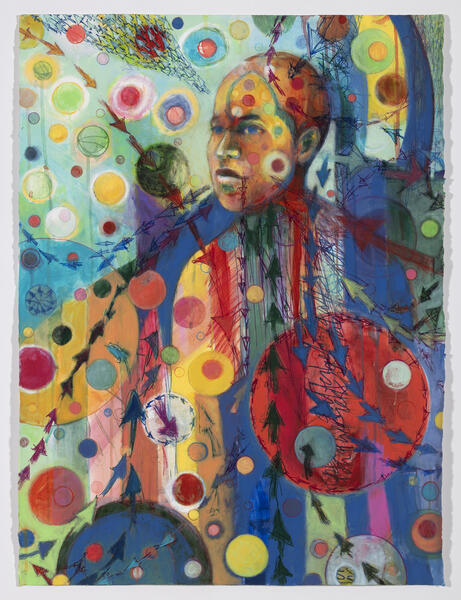 Transmission“Transmission” considers connection, communication and isolation during the pandemic as inhaling and exhaling at close range is risky. One of ‘the gifts of COVID-19’ is discovering alternate ways to cultivate community and practice self-leadership. Though physically separated from one another, we continue to share experiences, exchange ideas, images and support. acrylic, graphite, marker and colored pencil on paper 31"x22.5"
Transmission“Transmission” considers connection, communication and isolation during the pandemic as inhaling and exhaling at close range is risky. One of ‘the gifts of COVID-19’ is discovering alternate ways to cultivate community and practice self-leadership. Though physically separated from one another, we continue to share experiences, exchange ideas, images and support. acrylic, graphite, marker and colored pencil on paper 31"x22.5" -
 LED Board, Baltimore
LED Board, Baltimore
Birds
I've always loved birds. No matter what happens in the world, I continue to find solace in their presence. I watch for them, listen to their conversations and trust that nests will continue to be made, baby birds will be born, and one day leave those nests. Birds continue to find a place in my paintings.
-
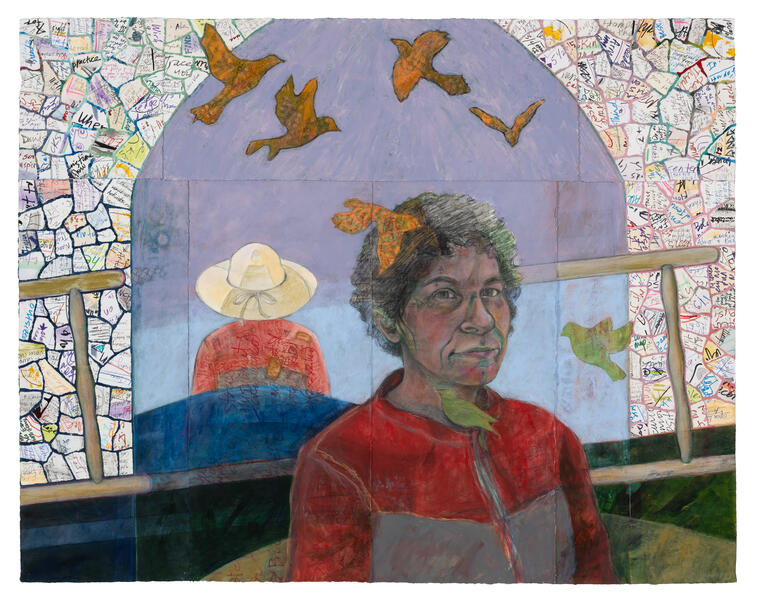 Future Present
Future PresentAcrylic, graphite and torn to-do lists on paper, “30”x39”
Available for Purchaseprice on request
-
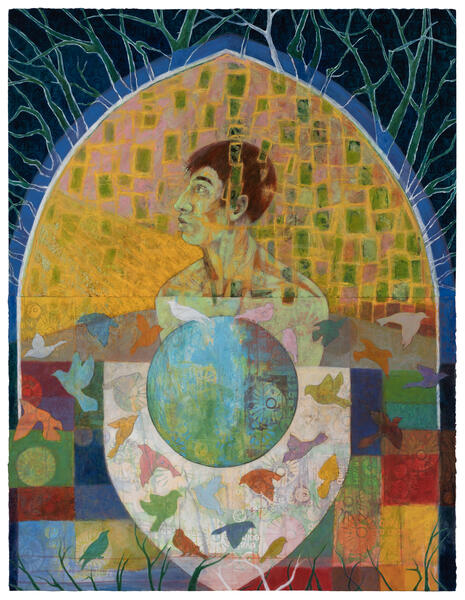 Percolation Pose
Percolation PosePercolation Pose
(from the Human Icon series)
The less I understand about where people go after their bodies die, the more credence I give to the birds as intermediaries between worlds, as though they don't recognize a dividing line. Birds will continue to find a place in my paintings.
Acrylic, graphite, colored pencil, hand-cut stamps and stencils on paper, 52”x 42”, 2023
Available for PurchasePrice on request
-
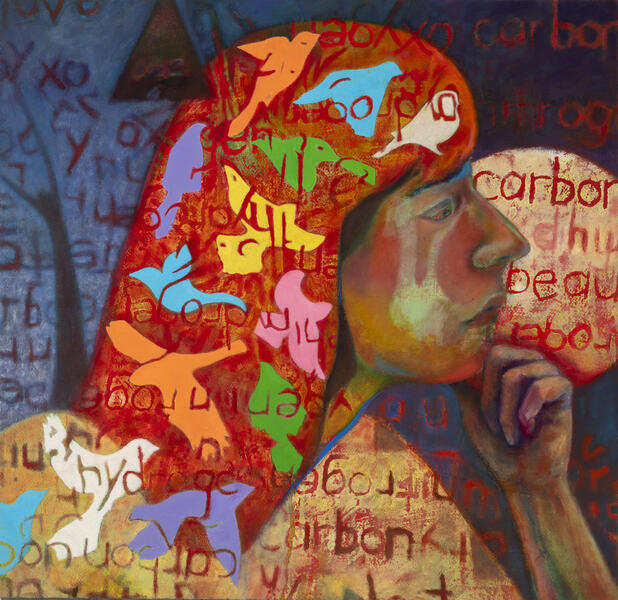 Navigating Tendrils
Navigating TendrilsThe stuff of life: hydrogen, oxygen, nitrogen, carbon, beauty / The words we say to ourselves and others / Birds nesting, fledging, holding on, letting go
oil, acrylic, graphite and hand-cut stamps on paper, 21"x21.5"
-
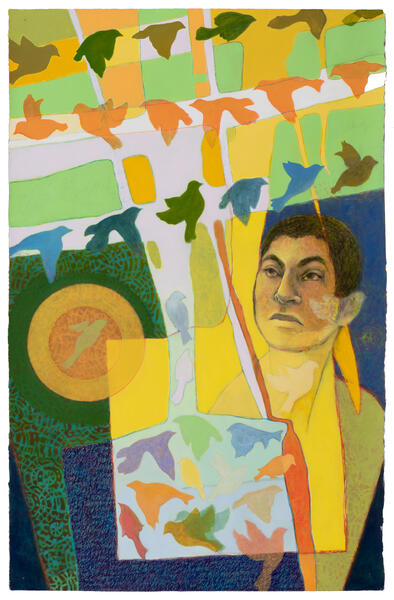 Unfolding
UnfoldingUnfolding
acrylic, graphite and colored pencil on paper, 42"x26"
Available for PurchasePrice on request
-
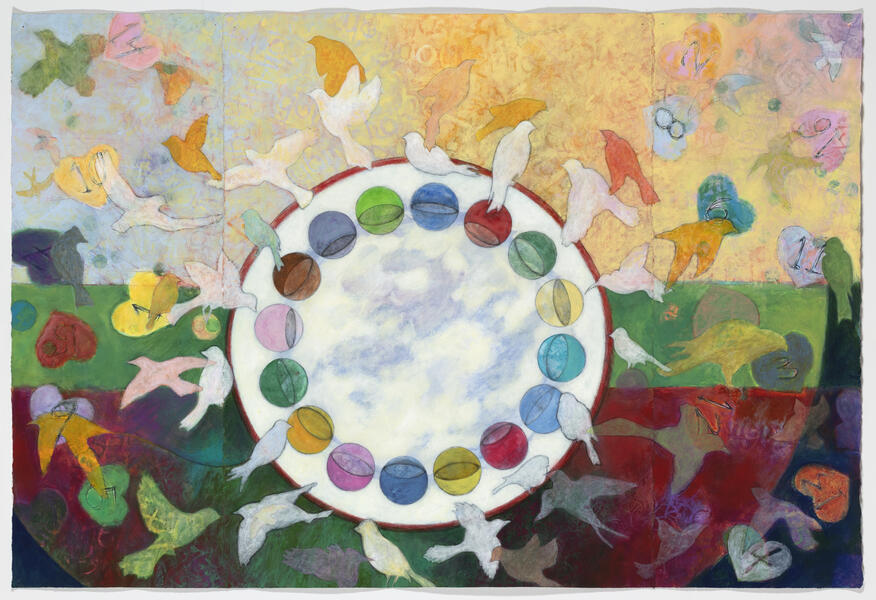 Come and Go
Come and Go“Come and Go”, inspired by my painting class, became our circle as if we were meeting in person. There’s a bowl for each student. Bowls are symbolic of giving and receiving. Birds dip into the circle and fly away in different directions. The horizon line grounds the group.
acrylic, graphite, marker and colored pencil 31"x45"
-
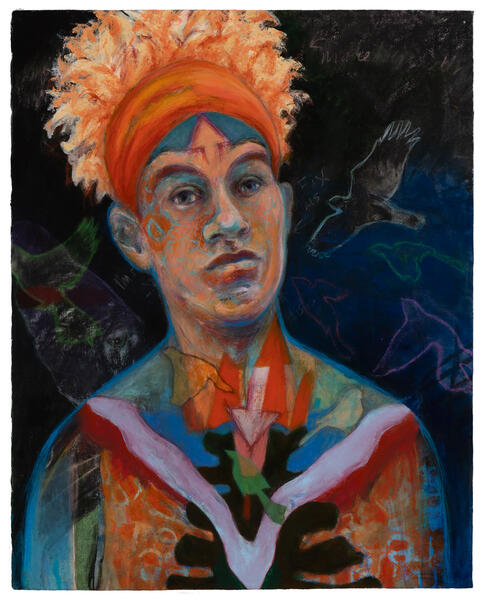 Inhalation
InhalationInhalation
acrylic, charcoal and pastel on paper
-
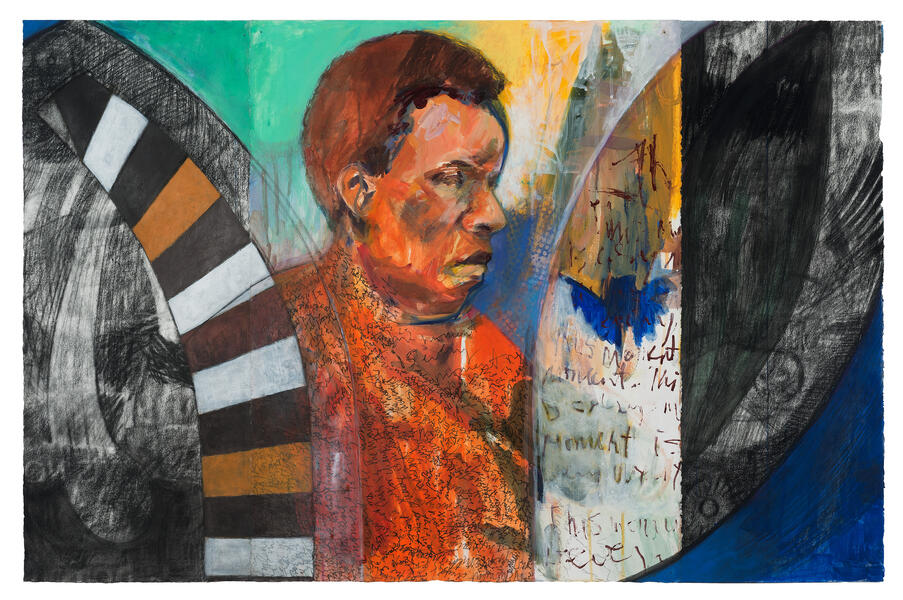 This Moment is Every Moment
This Moment is Every MomentThis Moment is Every Moment
(from the Human Icon series)
acrylic, charcoal, marker and graphite on paper, 30"x44"
Available for PurchasePrice on request
-
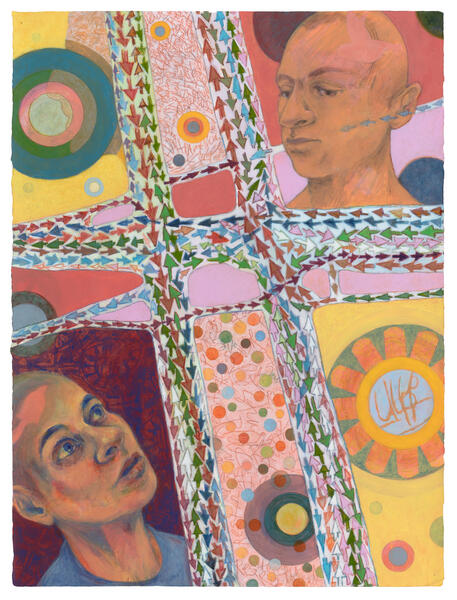 Up
UpUp
acrylic, graphite, colored pencil and hand-cut stencils on paper, 30"x22"
-
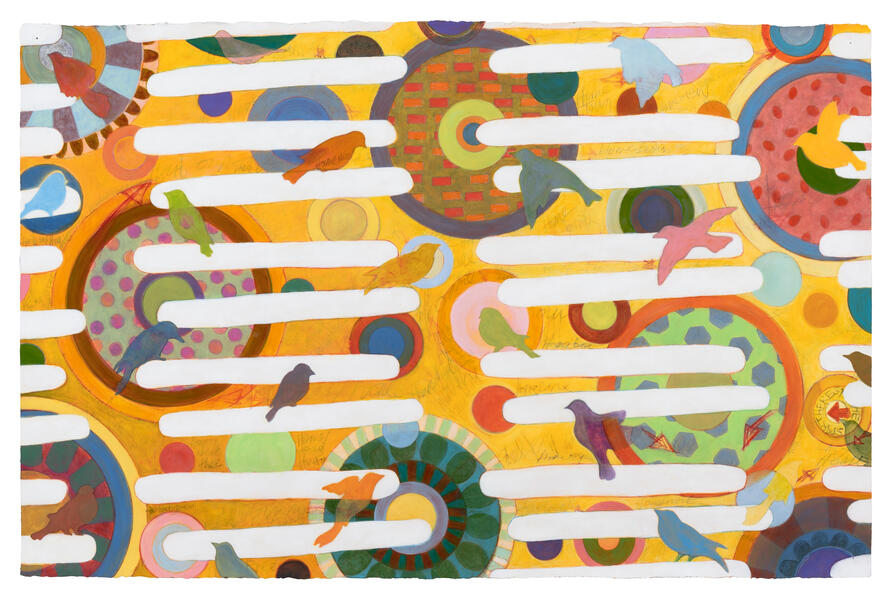 Home Care
Home CareHome Care
acrylic, graphite, colored pencil and hand-cut stencils and stamps on paper, 42"x26"
-
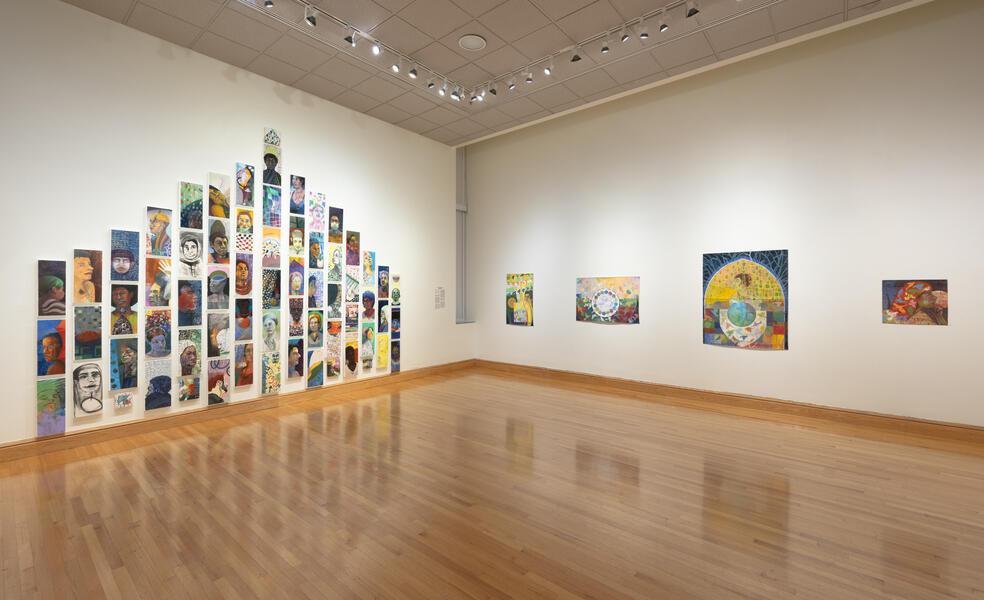 Installation including several Bird paintings
Installation including several Bird paintingsInstallation including several Bird paintings.
Tearing Prayers, Arrows, and Video Interviews
My grandmother, mother and aunts recited daily rosaries into their 80’s and 90’s. Their hands worked a well-worn path from the crucifix to the first few beads, around the loop and back. They prayed, paced and rocked. They prayed while vacuuming, making sauce, changing diapers. Prayers, were in their DNA.
I started tearing arrows from old paintings and to-do lists during the 2015 uprisings in Baltimore following the death of Freddie Gray while in police custody. In heartbreak, I was reminded of the women with their rosaries and my own childhood laps around the beads. For me, tearing arrows has become a form of prayer. I continue to make them. There will always be people and places needing love.
The arrow paintings and installations represent emphasis, attention, inner wisdom, a choice and the power of individuals and groups to create change together.
Three video interviews are part of the“Motivation on Monday” series by Myles Banks of Just Stunt Productions.
-
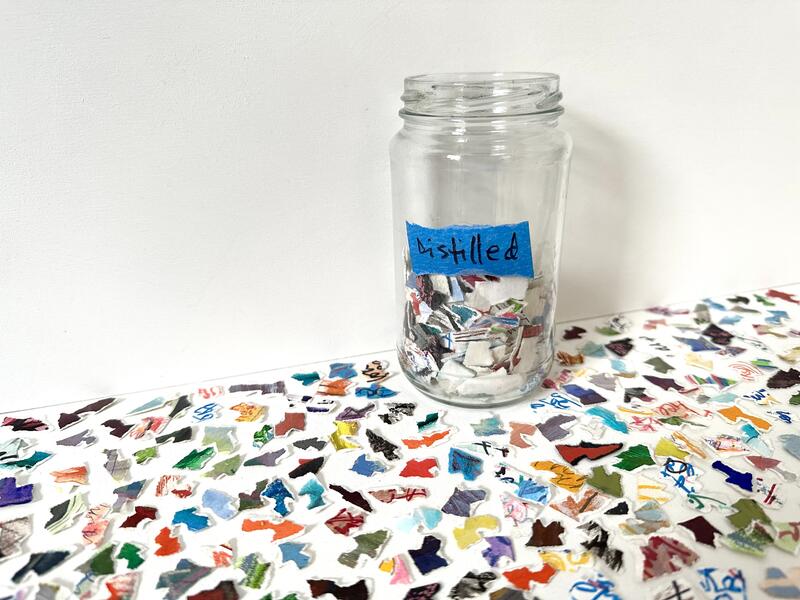 Distilled (1/2"or smaller)
Distilled (1/2"or smaller)Distilled, begun several years ago, is an ongoing group of tiny (1/2"or smaller) hand-torn arrows. Like the larger arrows, they are prayers for people and places. These arrows are harder to tear because of their size so I spend more time with them. Small can be powerful.
acrylic, marker, colored pencil, graphite on paper
-
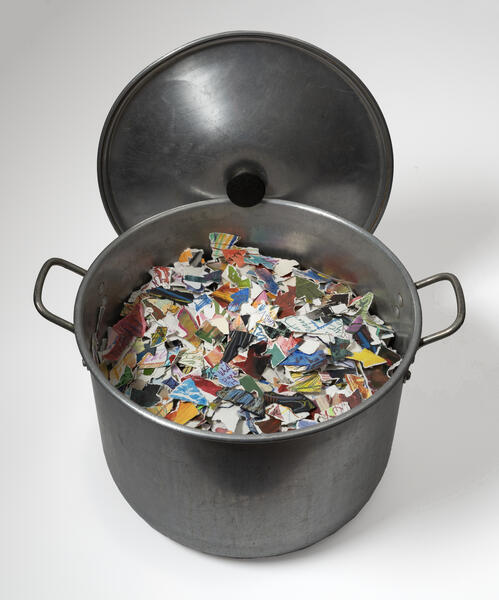 Tearing PrayersMy grandmother, mother and aunts recited daily rosaries into their 80’s and 90’s. Their hands worked a well-worn path from the crucifix to the first few beads, around the loop and back. They prayed, paced and rocked. They prayed while vacuuming, making sauce, changing diapers. Prayers, were in their DNA. I started tearing arrows from old paintings and to-do lists during the 2015 uprisings in Baltimore following the death of Freddie Gray while in police custody. In heartbreak, I was reminded of the women with their rosaries and my own childhood laps around the beads. For me, tearing arrows has become a form of prayer. I continue to make them. There will always be people and places needing love.
Tearing PrayersMy grandmother, mother and aunts recited daily rosaries into their 80’s and 90’s. Their hands worked a well-worn path from the crucifix to the first few beads, around the loop and back. They prayed, paced and rocked. They prayed while vacuuming, making sauce, changing diapers. Prayers, were in their DNA. I started tearing arrows from old paintings and to-do lists during the 2015 uprisings in Baltimore following the death of Freddie Gray while in police custody. In heartbreak, I was reminded of the women with their rosaries and my own childhood laps around the beads. For me, tearing arrows has become a form of prayer. I continue to make them. There will always be people and places needing love. -
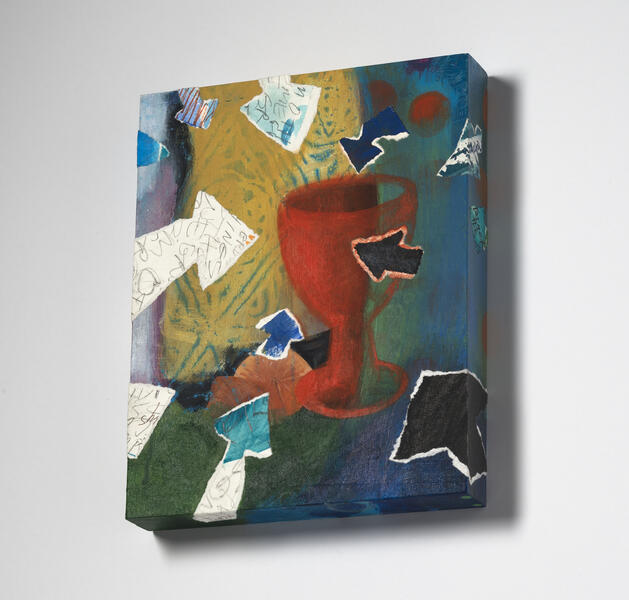 UrgentUrgent calls attention to the objects we use and rituals we perform on a daily basis. 10“x8”x1.5”, acrylic, ink and torn-up old paintings on panel
UrgentUrgent calls attention to the objects we use and rituals we perform on a daily basis. 10“x8”x1.5”, acrylic, ink and torn-up old paintings on panel -
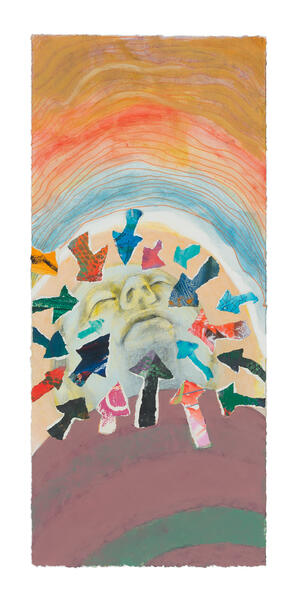 Surround SoundSurround Sound This painting was created following the death of a family member. In the moment of passing senses are elevated, time stands still. 22“x10”x1.5”, acrylic, ink, colored pencil, marker, graphite, and torn old paintings and to-do lists on paper mounted on wooden panel
Surround SoundSurround Sound This painting was created following the death of a family member. In the moment of passing senses are elevated, time stands still. 22“x10”x1.5”, acrylic, ink, colored pencil, marker, graphite, and torn old paintings and to-do lists on paper mounted on wooden panel -
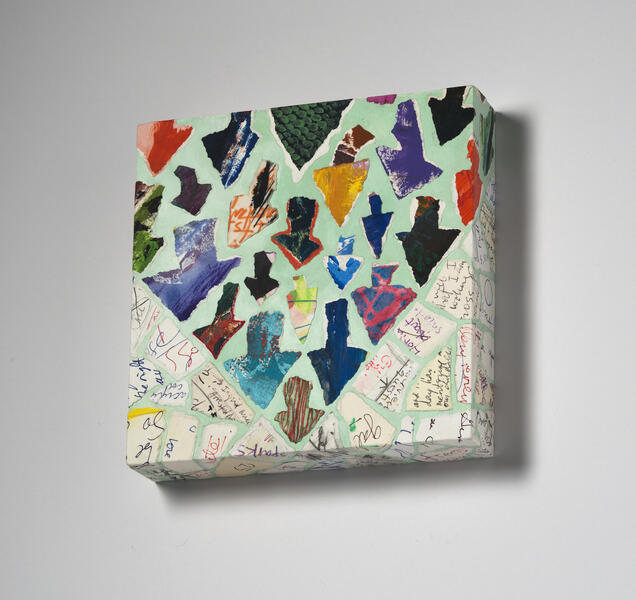 WedgeWedge is the potential power of a group when they move in one direction. acrylic, ink, colored pencil, graphite, marker, old torn paintings, to-do lists and arrows on panel 12"x12"x1.5"
WedgeWedge is the potential power of a group when they move in one direction. acrylic, ink, colored pencil, graphite, marker, old torn paintings, to-do lists and arrows on panel 12"x12"x1.5" -
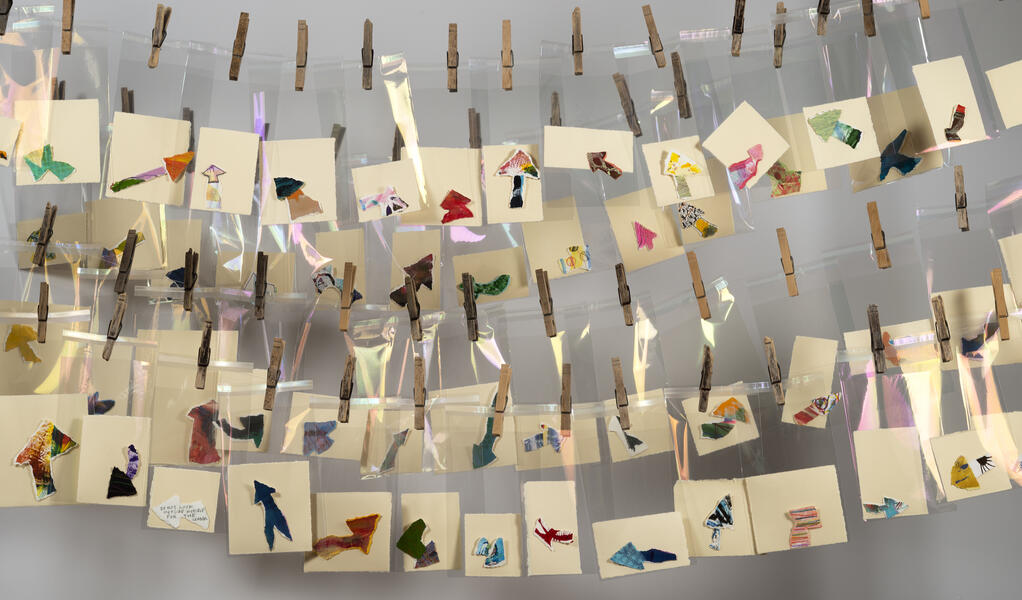 Ear to the GroundEar to the Ground This piece focuses on individual choices made that together form a multitude and a less than straight path. acrylic, ink, colored pencil, graphite, hand torn arrows, plastic sleeves, clothes pins and line size variable
Ear to the GroundEar to the Ground This piece focuses on individual choices made that together form a multitude and a less than straight path. acrylic, ink, colored pencil, graphite, hand torn arrows, plastic sleeves, clothes pins and line size variable -
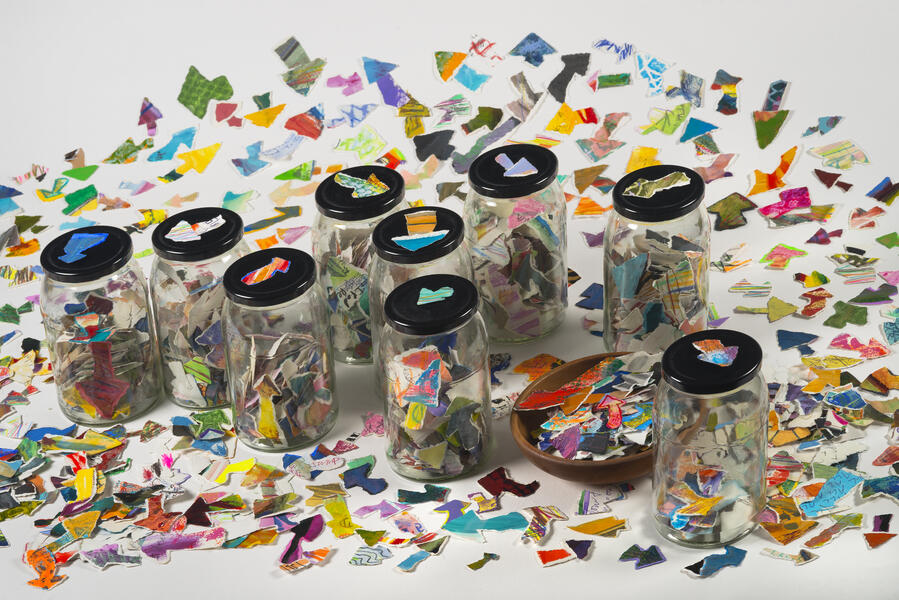 Jarred Loose7“x62”x24”, acrylic, ink, colored pencil, graphite, marker, hand-torn arrows from old paintings and to-do lists, glass jars
Jarred Loose7“x62”x24”, acrylic, ink, colored pencil, graphite, marker, hand-torn arrows from old paintings and to-do lists, glass jars -
Untitled Flag exhibit interview with Myles Banks
-
Reframing Your MindThis video, part of a series called “Motivation on Monday”, was filmed and edited by Myles Banks of Just Stunt Productions. Being willing to have conversations is another possibilty for coming together.
-
Your Thoughts Are PowerfulThis video, part of a series called “Motivation on Monday”, was filmed and edited by Myles Banks of Just Stunt Productions. Being willing to have conversations is another possibility for coming together.
What Makes Us (Us) portrait installation
Gina Pierleoni: What Makes Us (Us)
at Creative Alliance, Baltimore, MD
Exhibition Statement
Everyone deserves to be seen and heard.
Over the past 26 years, I created nearly 300 portraits of people across the spectrum of familiarity. These images push past labels and judgements as they question perception, habit, and bias in how we place ourselves in relation to others. What Makes Us (Us) is the first time nearly the entire series has been displayed in one place.
In the late 1970s and early 1980s, I frequently sketched commuters and the homeless population inside Grand Central Station in New York. Sometimes I would have a conversation that resulted in the person asking to have their portrait drawn. The volunteers were almost exclusively homeless. I offered the drawing as a thank you for our time together. The more I showed up, the more people would ask me to draw them. The deeper the connection, the closer the image resembled the sitter.
During the same years, I bartended at a train station lounge. Some of the regulars were Vietnam veterans, who shared their struggles to reintegrate. Their compassion for one another regardless of rank was touching. Drawing portraits of them created conversations. I noticed parallel shame and invisibility among the homeless and veterans.
Sketching became a form of advocacy. I didn’t imagine these drawings would one day provide a gateway to my own healing, form the central philosophy for my teaching and community building, and build a platform for the art I cared about making.
When the series began, I made several drawings of my voice. The first portraits, emotionally raw unearthings, used mostly charcoal lines. The process was physical, empowering. Each year I added more portraits. The pieces were reworked over months, years until the images came alive. Using a similar scale created an absence of hierarchy.
I use portraiture to spark conversations about empathy and our common humanity. Portrait painting demands curiosity, stillness and deep observation. My portraits are multi-layered: drawn, painted, scratched into, stamped and stenciled under, over and through the surfaces. I am painting from the inside out to convey the emotional fabric of someone, in addition to how they look. These are real people, alive, changing, genuine and vulnerable.”
-
 What Makes Us (Us)
What Makes Us (Us) -
Interview with Gina PierleoniVideo interview of Gina Pierleoni at the opening of What Makes Us (Us) at Creative Alliance.
-
 What Makes Us (Us) installationWhat Makes Us (Us) installation at Creative Alliance featuring 241 portraits
What Makes Us (Us) installationWhat Makes Us (Us) installation at Creative Alliance featuring 241 portraits -
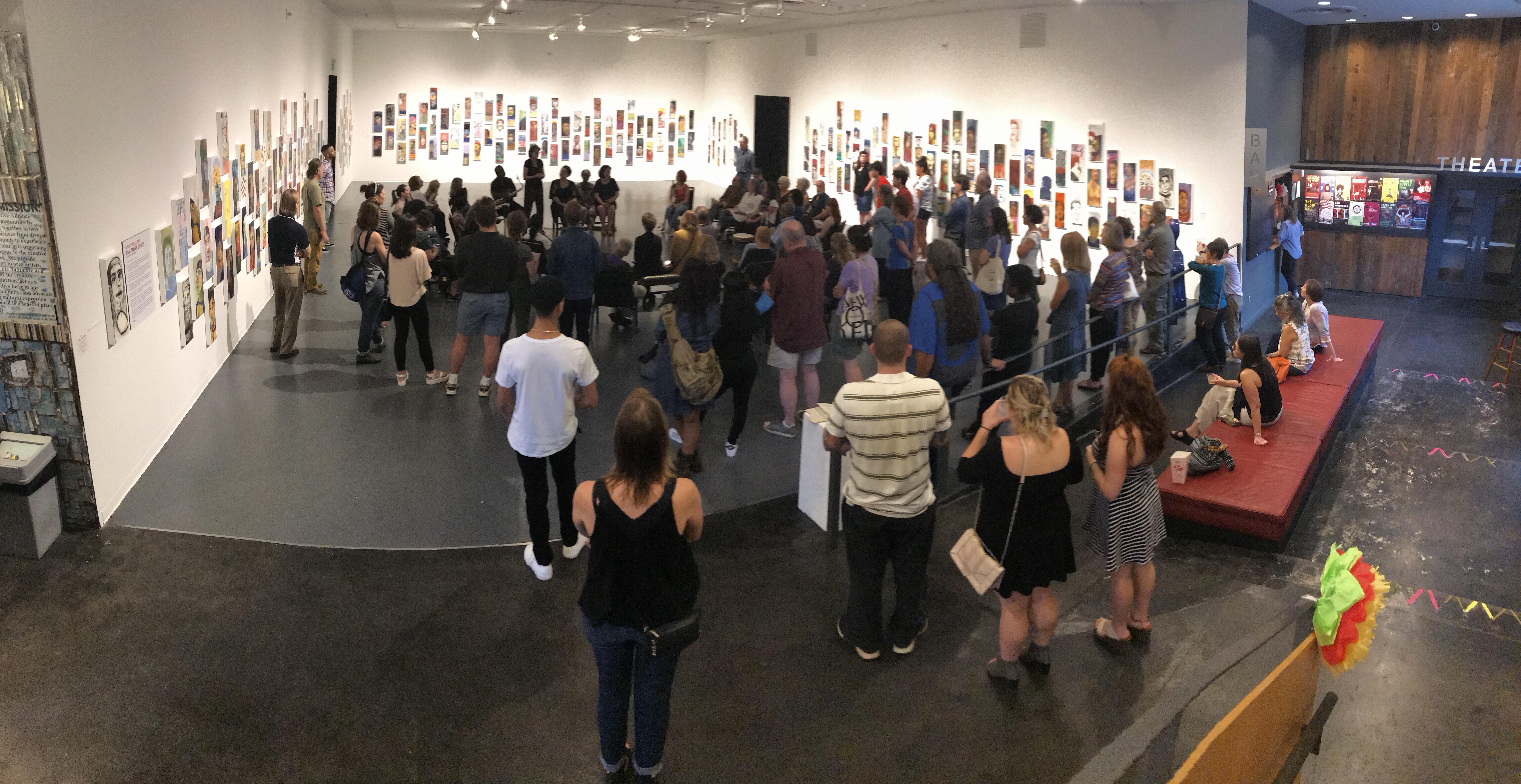 Making ConversationsFollowing an artist talk, 'Making Conversation' premiered during the run of 'What Makes Us (US)'. An original performance, it featured four local musicians who had never played together: Benny Russell, Helen Yuen, Cliff Giles and Sera Bailey-Emberson. Using long pieces of bamboo with chalk stuffed in one end, audience participants drew on the gallery floor inspired by the improvisational sounds they heard.
Making ConversationsFollowing an artist talk, 'Making Conversation' premiered during the run of 'What Makes Us (US)'. An original performance, it featured four local musicians who had never played together: Benny Russell, Helen Yuen, Cliff Giles and Sera Bailey-Emberson. Using long pieces of bamboo with chalk stuffed in one end, audience participants drew on the gallery floor inspired by the improvisational sounds they heard. -
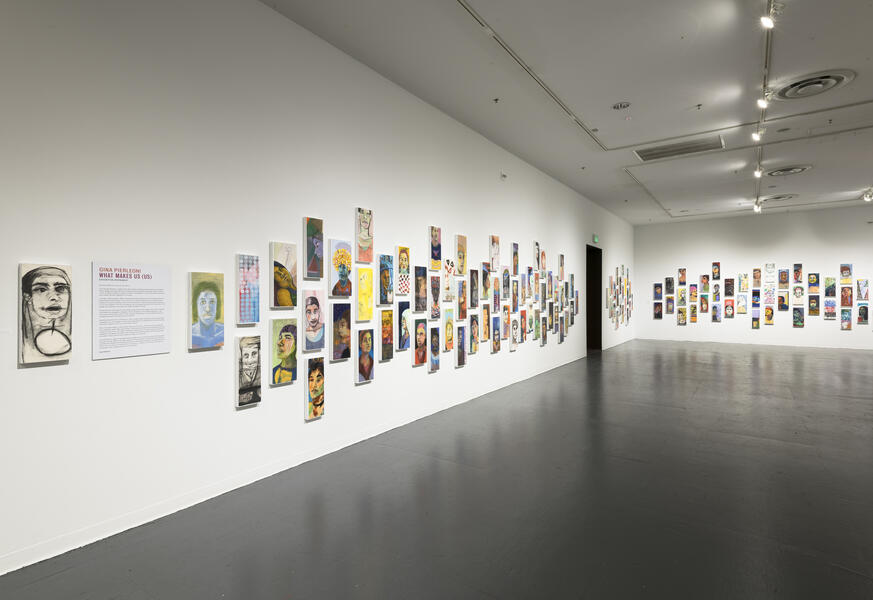 What Makes Us (Us) installation detailWhat Makes Us (Us) installed at Creative Alliance detail
What Makes Us (Us) installation detailWhat Makes Us (Us) installed at Creative Alliance detail -
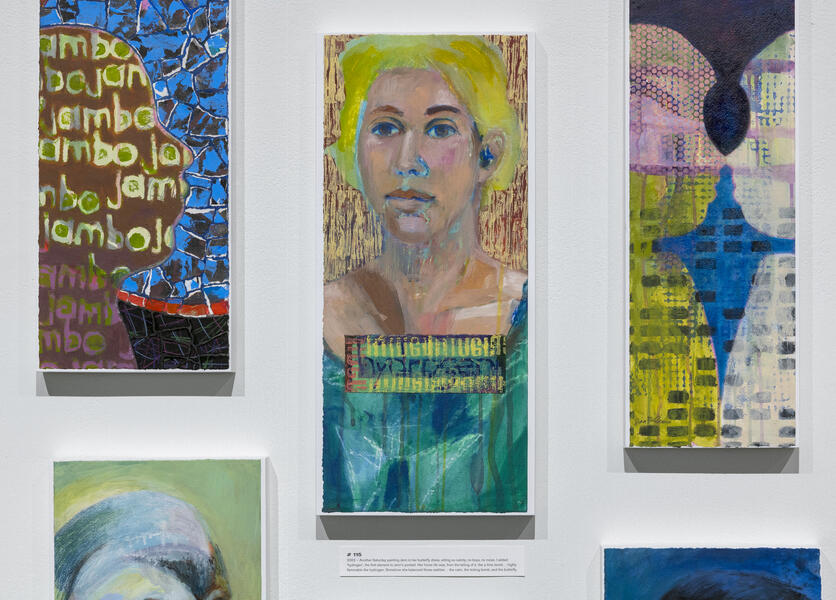 What Makes Us (Us) detail#115 (pictured center) Another Saturday painting Jenn in her butterfly dress, sitting so calmly, no boys, no noise. I added ‘hydrogen’, the first element to Jenn’s portrait. Her home life was, from the telling of it, a time bomb… highly flammable like hydrogen. Somehow she balanced those realities… the calm, the ticking bomb, and the butterfly. Each portrait in the installation has notes written on the reverse side. They reference the sitter, the process or what was going on at the time the painting was made. In this installation of over 240 portraits, about 15 paintings had text revealed.
What Makes Us (Us) detail#115 (pictured center) Another Saturday painting Jenn in her butterfly dress, sitting so calmly, no boys, no noise. I added ‘hydrogen’, the first element to Jenn’s portrait. Her home life was, from the telling of it, a time bomb… highly flammable like hydrogen. Somehow she balanced those realities… the calm, the ticking bomb, and the butterfly. Each portrait in the installation has notes written on the reverse side. They reference the sitter, the process or what was going on at the time the painting was made. In this installation of over 240 portraits, about 15 paintings had text revealed. -
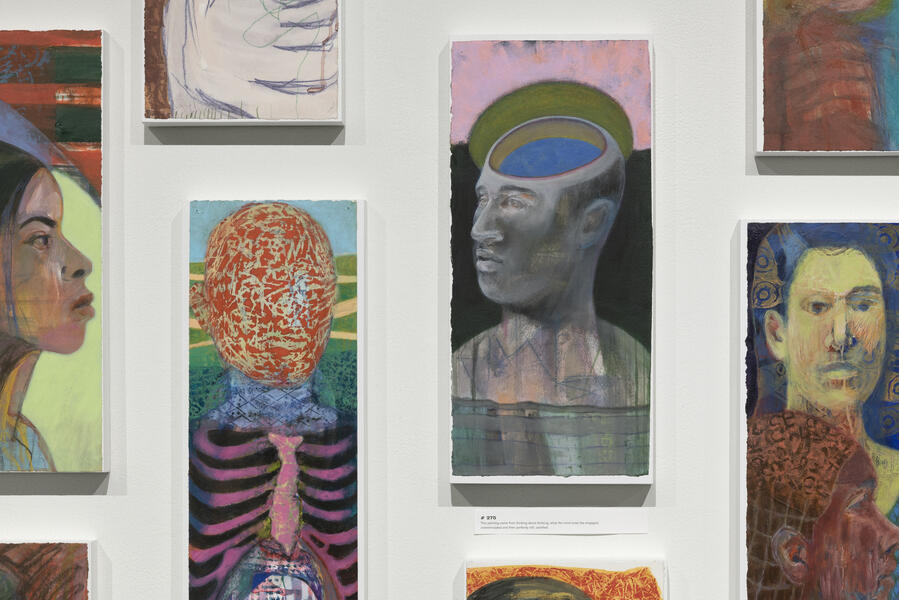 What Makes Us (Us) detail"#275 (pictured center right) This painting came from thinking about thinking, what the mind looks like engaged, overstimulated and then perfectly still, satisfied. Each portrait in the installation has notes written on the reverse side. They reference the sitter, the process or what was going on at the time the painting was made. In this installation of over 240 portraits, about 15 paintings had text revealed.
What Makes Us (Us) detail"#275 (pictured center right) This painting came from thinking about thinking, what the mind looks like engaged, overstimulated and then perfectly still, satisfied. Each portrait in the installation has notes written on the reverse side. They reference the sitter, the process or what was going on at the time the painting was made. In this installation of over 240 portraits, about 15 paintings had text revealed. -
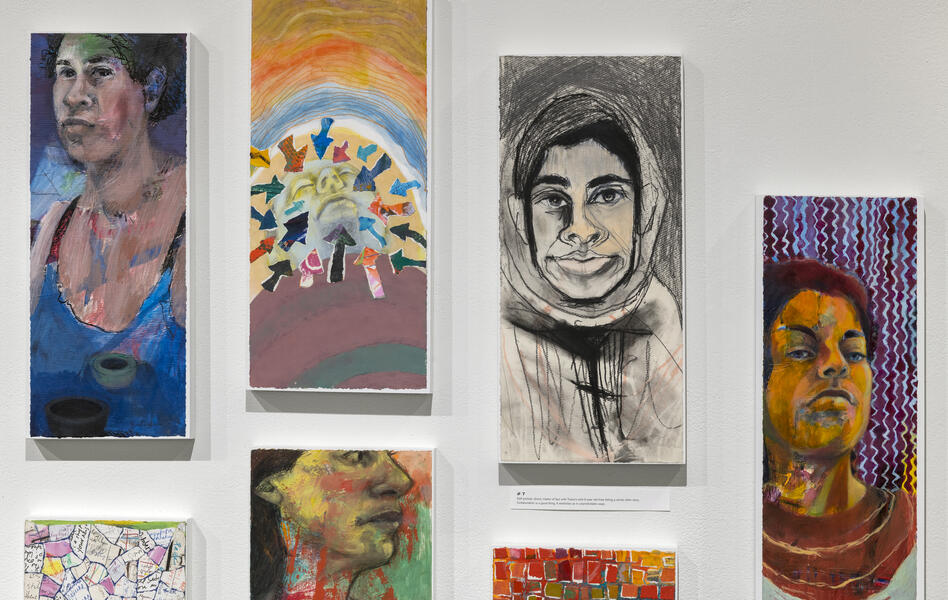 What Makes Us (Us) detail#7 (pictured center right) Self Portrait, direct, matter of fact with Trane's wild 3-year old lines telling a whole other story. Collaboration is a good thing. It stretches us in unpredictable ways." Each portrait in the installation has notes written on the reverse side. They reference the sitter, the process or what was going on at the time the painting was made. In this installation of over 240 portraits, about 15 paintings had text revealed.
What Makes Us (Us) detail#7 (pictured center right) Self Portrait, direct, matter of fact with Trane's wild 3-year old lines telling a whole other story. Collaboration is a good thing. It stretches us in unpredictable ways." Each portrait in the installation has notes written on the reverse side. They reference the sitter, the process or what was going on at the time the painting was made. In this installation of over 240 portraits, about 15 paintings had text revealed. -
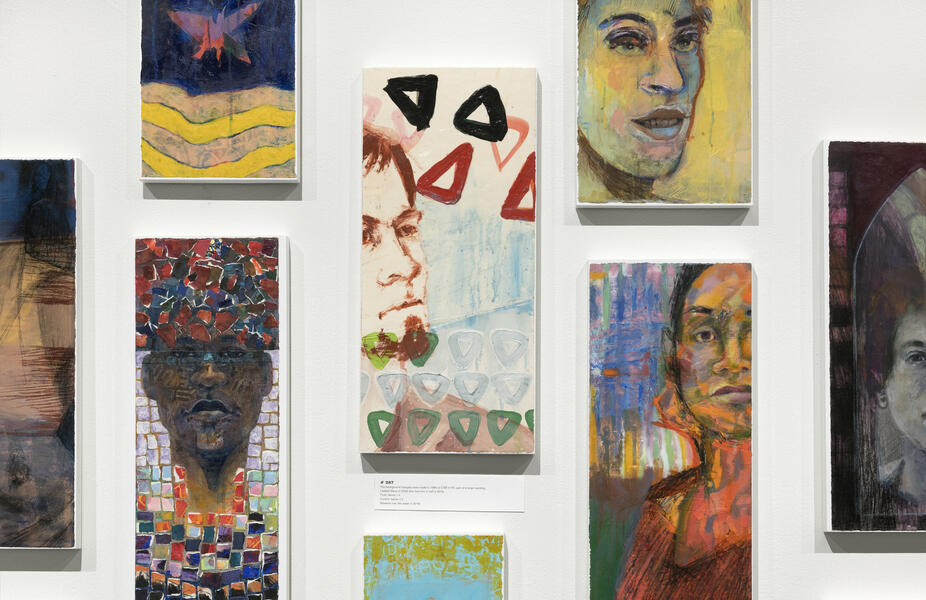 What Makes Us (Us) detail#287 (pictured center) The background triangles were made in 1980 at CNR in NY, part of a larger painting. I added Steve in 2002 then tore him in half in 2016. Trust: above triangles Control: below triangles Washed over like water in 2018 Each portrait in the installation has notes written on the reverse side. They reference the sitter, the process or what was going on at the time the painting was made. In this installation of over 240 portraits, about 15 paintings had text revealed.
What Makes Us (Us) detail#287 (pictured center) The background triangles were made in 1980 at CNR in NY, part of a larger painting. I added Steve in 2002 then tore him in half in 2016. Trust: above triangles Control: below triangles Washed over like water in 2018 Each portrait in the installation has notes written on the reverse side. They reference the sitter, the process or what was going on at the time the painting was made. In this installation of over 240 portraits, about 15 paintings had text revealed. -
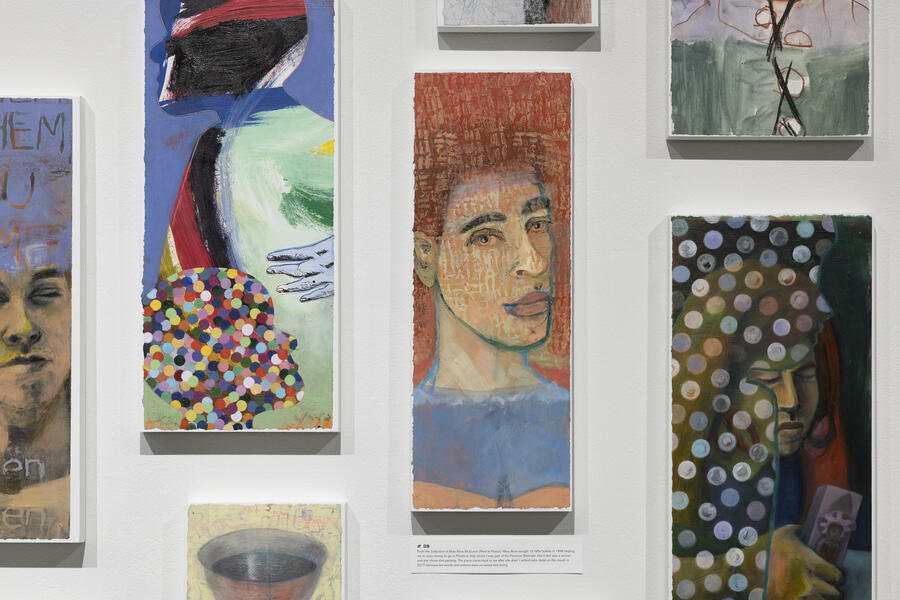 What Makes Us (Us) detail#28 (pictured center right) From the collection of Mary Alice McGurrin (Rest in Peace). Mary Alice bought 10 raffle tickets in 1999 helping me to raise money to go to Florence, Italy where I was part of the Florence Biennale. Her ticket was a winner and she chose this painting. The piece came back to me after she died. I added extra detail on the mouth in 2017 because her words and actions were so sweet and loving. Each portrait in the installation has notes written on the reverse side. They reference the sitter, the process or what was going on at the time the painting was made. In this installation of over 240 portraits, about 15 paintings had text revealed.
What Makes Us (Us) detail#28 (pictured center right) From the collection of Mary Alice McGurrin (Rest in Peace). Mary Alice bought 10 raffle tickets in 1999 helping me to raise money to go to Florence, Italy where I was part of the Florence Biennale. Her ticket was a winner and she chose this painting. The piece came back to me after she died. I added extra detail on the mouth in 2017 because her words and actions were so sweet and loving. Each portrait in the installation has notes written on the reverse side. They reference the sitter, the process or what was going on at the time the painting was made. In this installation of over 240 portraits, about 15 paintings had text revealed.
Sewn Figures
The sewn figures parallel my painting and mixed media processes. Stitching is drawing, fabric is paint, and attached objects create layers. Through collecting, sorting and valuing, materials headed for the landfill are sewn together to make something whole again.
Each figure is made entirely from discarded and re-purposed materials (except for thread and paint). Materials have included: electric toothbrush rings, gift bag handles, any small things with holes in them, shoelaces, broken costume jewelry, hospital socks, old beads and buttons, rosaries and medals of saints, graduation tassels, sequins, leather scraps, fabric and yarn. Everything is sewn together with a simple looping stitch.
-
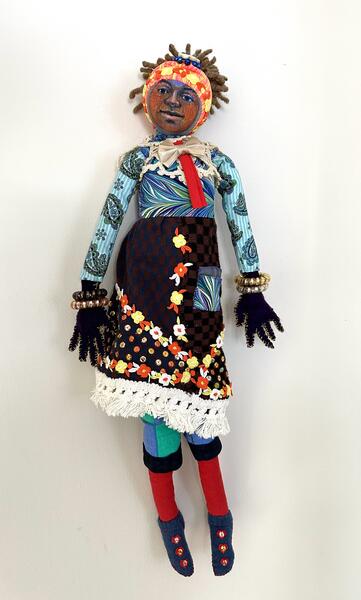 Taproot
TaprootHand-sewn figure made from 100% recycled and repurposed materials excluding thread.
25"x10"x6"
-
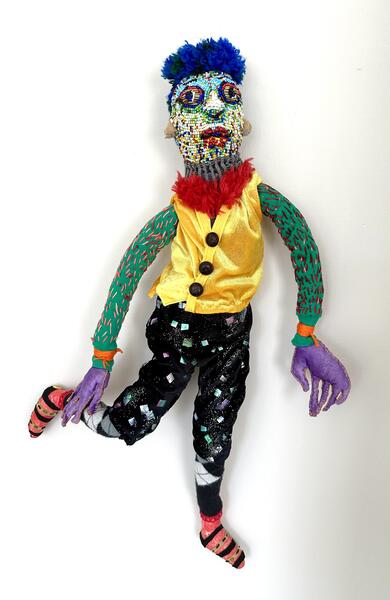 Happenstance
HappenstanceHand-sewn figure made from 100% recycled and repurposed materials excluding thread and beads.
24"x12"x5"
-
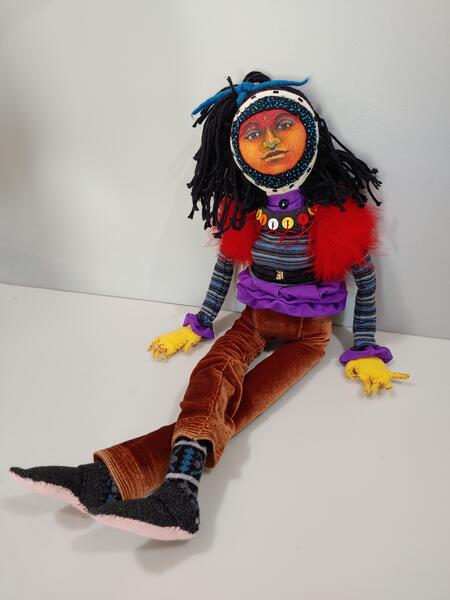 Velveteen
VelveteenHand-sewn figure made from 100% recycled and repurposed materials excluding thread.
23"x8"x6"
-
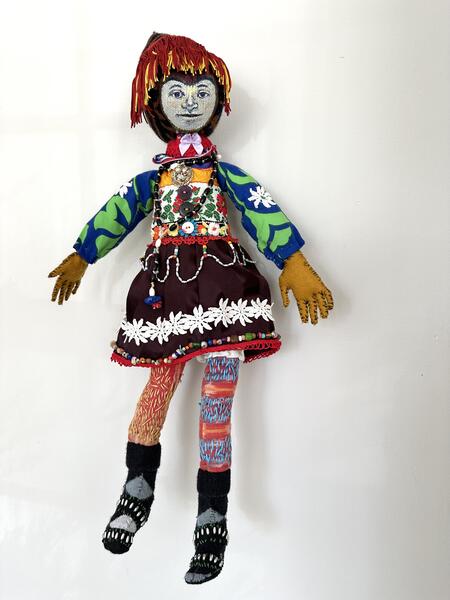 Broken Rosary
Broken RosaryHand-sewn figure made from 100% recycled and repurposed materials excluding thread and beads.
21"x14"x8"
-
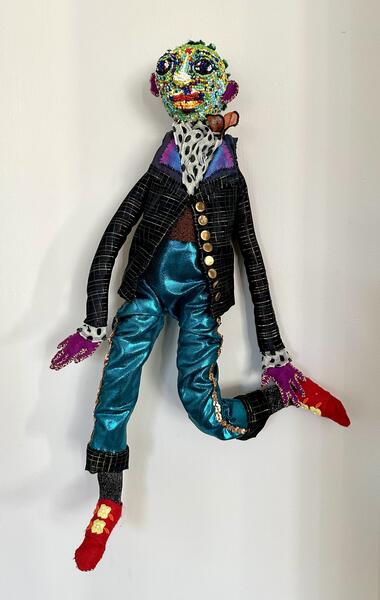 A Particular Direction
A Particular DirectionHand-sewn figure made from 100% recycled and repurposed materials excluding thread and beads.
22"x12"x5"
Available for PurchasePrice on reqwuest
-
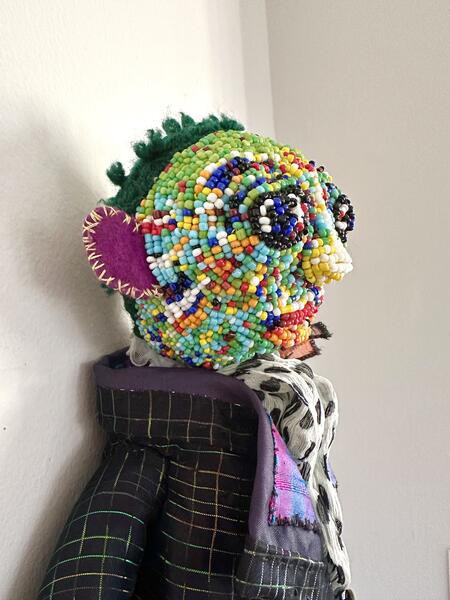 A Particular Direction (detail)
A Particular Direction (detail) -
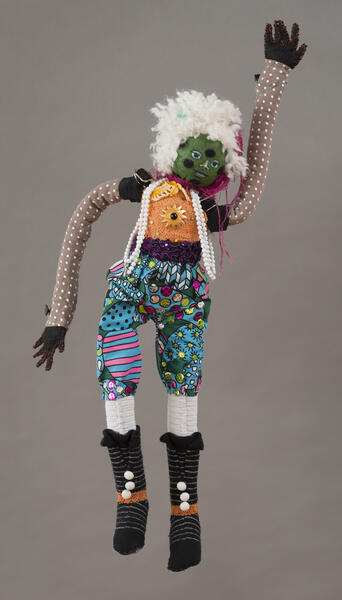 Glisten
GlistenHand-sewn figure made from 100% recycled and repurposed materials excluding thread and breads.
Available for PurchasePrice on request
-
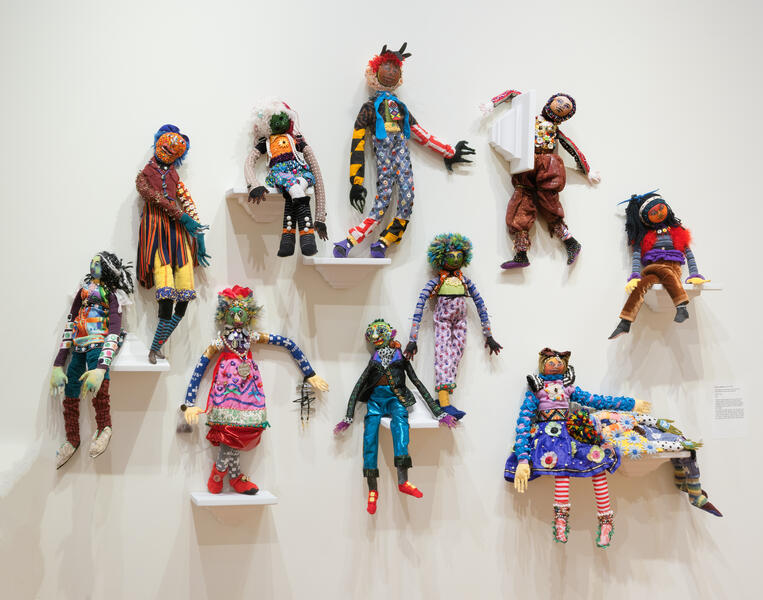 SewnFigures
SewnFiguresHand-sewn figure made from 100% recycled and repurposed materials excluding thread. Sizes vary.
Sewn Figures installation at 'Unfolding', Stevenson University Greenspring Campus, MD
Available for Purchaseprices on request
-
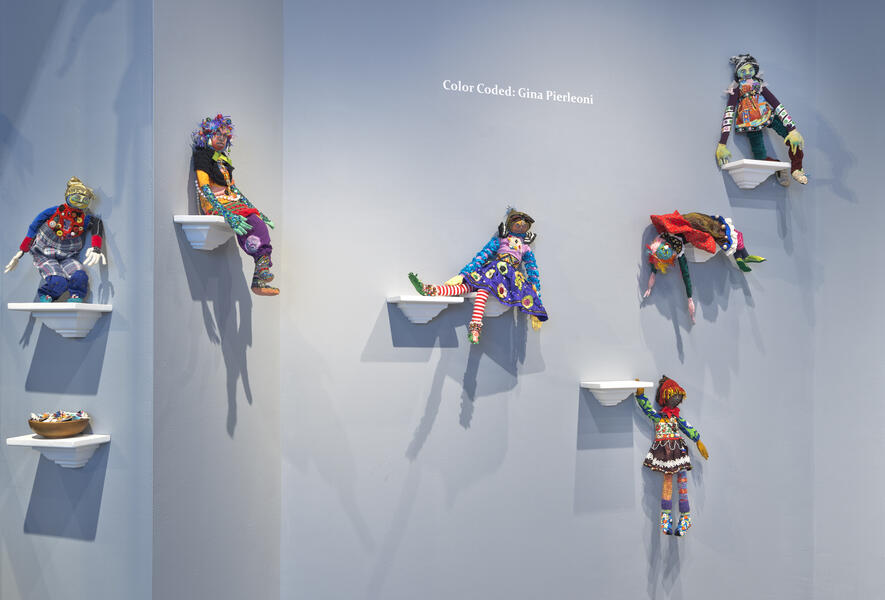 Color Coded installation detail
Color Coded installation detail -
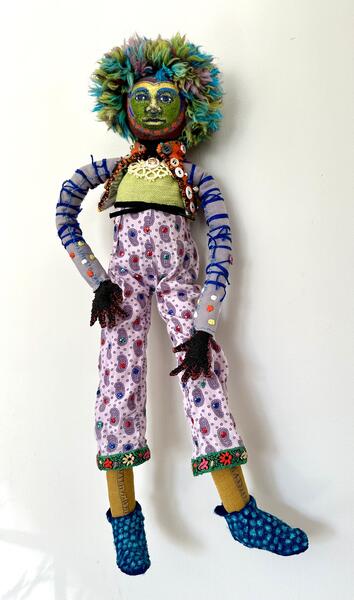 My Pajama Pants
My Pajama PantsHand-sewn figure made from 100% recycled and repurposed materials excluding thread.
22"x13"x5"
Painting Rag Shirts
Painting Rag Shirts
I’m making parallel sets of paintings: one intentional, the other created from what’s left behind. My painting rags have accumulated for over 40 years, a byproduct of wiping paint, blending it, and cleaning hand-cut stencil and stamps. My palette has changed many times over the years. Without any conscious effort, these cut up T-shirts rags become paintings.
The pieces are sorted into short and long sleeves, bottom edges, necklines and middle sections. A simple, visible hand-sewn looping stitch brings all the pieces together, unearthing their another T-shirt and implying the figure inside.
Some pieces like My Father’s Last Shirt are memorials. Fur Shirt is a collection of hundreds of small rag trimmings that together created unexpected billowing results.
There are so many things we give up on because we can’t envision the potential and inherent beauty in them: things, places, each other. For me, these former rags create an opportunity for embracing history, possibility and transformation.
-
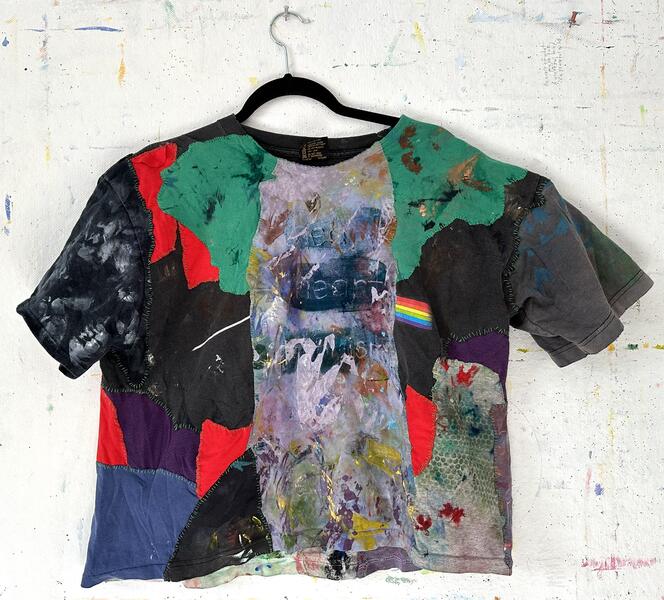 The Music
The MusicSomeone gave me an old, tattered Pink Floyd T-shirt I knew I'd never wear. Though the band and Dark Side of the Moon were part of my coming of age, it became a studio rag instantly. When searching for just the right scraps for a new shirt, I came across Pink Floyd again. I had to put a little piece on the image front and back, to create a place for the music.
-
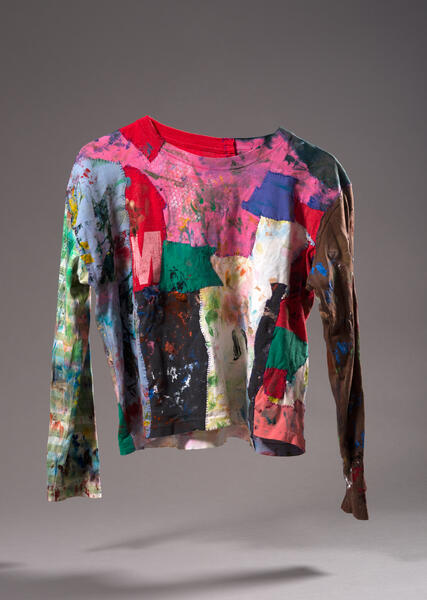 MPainting rags reassembled and sewn back together, acrylic and thread on cotton fabric
MPainting rags reassembled and sewn back together, acrylic and thread on cotton fabric -
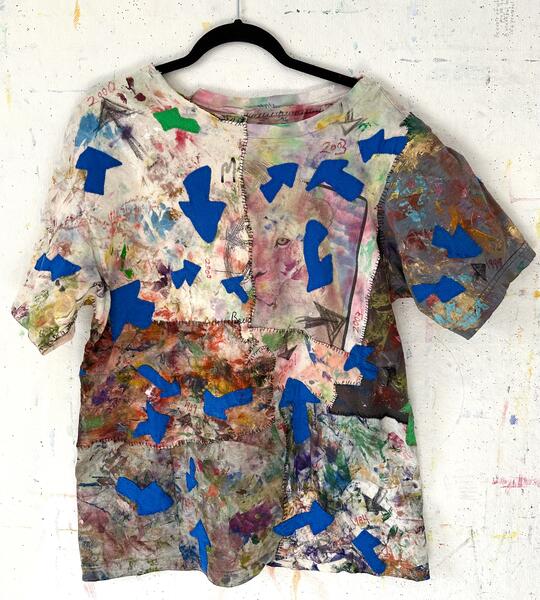 Literal Timeline
Literal TimelineWhen I was piecing this shirt together, I noticed the scraps were from different years based on my changing palette. I started dating each scrap from the 1980's, 90's, 2000's and beyond. Once the shirt was sewn together, I wanted to amplify the timeline of the paintings that made the rags. Arrows point to each year.
-
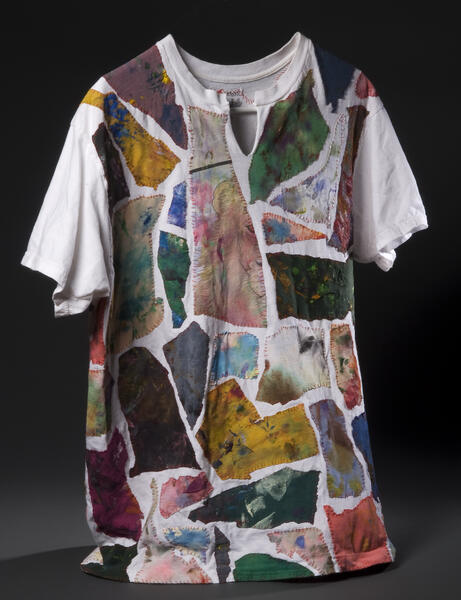 Last Shirt2 weeks before my father died, it became difficult to get T-shirts over his head and my mother cut the fronts for easier access. In this shirt, I created something to honor his transition, using a stone wall to describe his dying process. Stones are laid strong and firm. They protect us and mark where we are. Over time, stones fall down changing the shape of the wall. There is also an image of a lion on the front of the shirt. My father's last name (and mine) Pierleoni, means "father of the lion." Painting rags reassembled and sewn back together, acrylic and thread on cotton fabric
Last Shirt2 weeks before my father died, it became difficult to get T-shirts over his head and my mother cut the fronts for easier access. In this shirt, I created something to honor his transition, using a stone wall to describe his dying process. Stones are laid strong and firm. They protect us and mark where we are. Over time, stones fall down changing the shape of the wall. There is also an image of a lion on the front of the shirt. My father's last name (and mine) Pierleoni, means "father of the lion." Painting rags reassembled and sewn back together, acrylic and thread on cotton fabric -
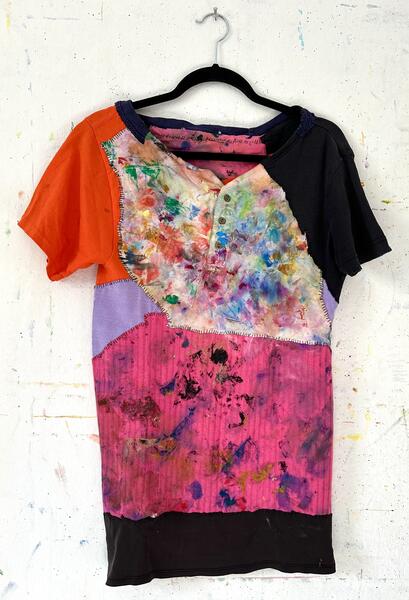 Layer Cake
Layer CakeAll I can think of when I look at this shirt is a layer cake. I'm reminded of the awkward layer cakes I made as a kid in my Easy Bake oven. I served them proudly, cut into 11 tiny pieces.
-
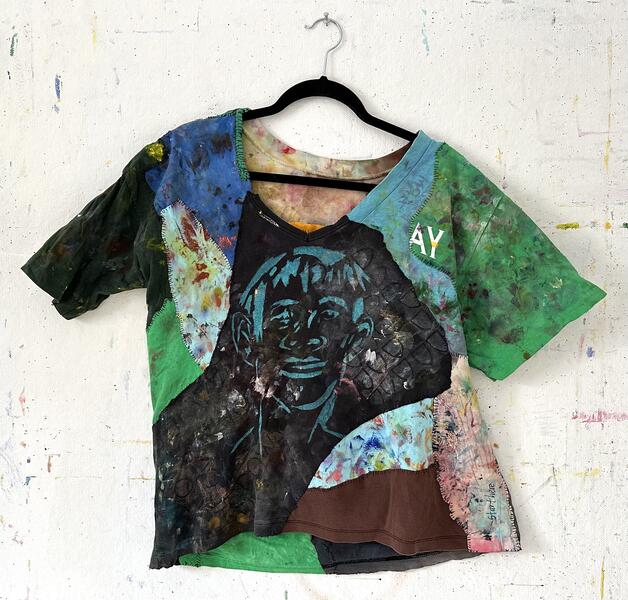 Ay
AyThe face on this shirt was originally on another T-shirt that wore out along the armpits and sleeves. I couldn't let my stencil portrait go, so I turned the image into part of the Painting Rag Shirts series, breathing new life into it again.
-
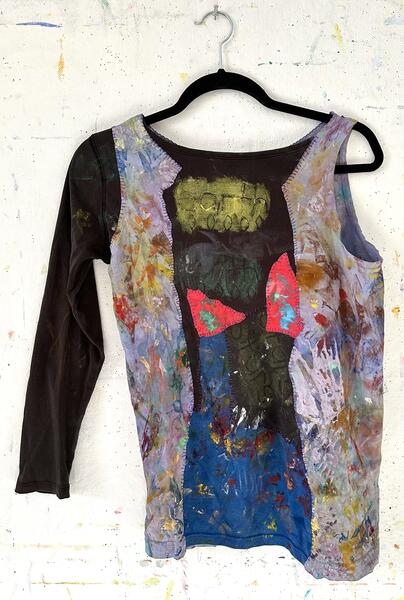 Earth Stars
Earth StarsThis shirt is mainly comprised of my two former favorite studio shirts, one long sleeved and one sleeveless. I was making word painting stamps, so 'earth' and 'stars' appear on the shirt in places. While cleaning the stamps, the words transferred to the shirt.
-
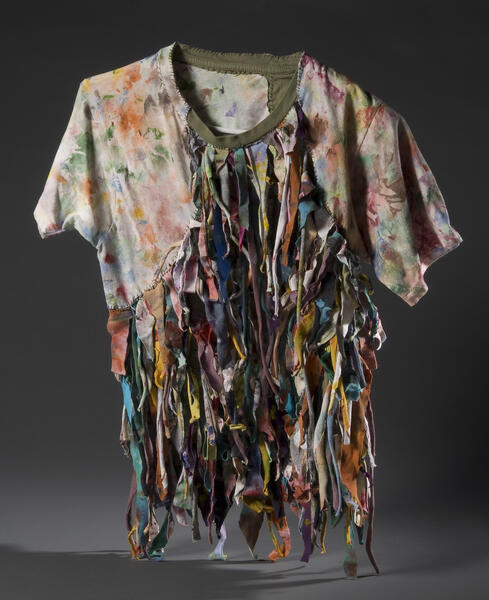 Fur Shirt
Fur ShirtAs an avid collector and recycler, it is difficult to throw away the littlest scraps, especially when they are so beautiful. The Fur Shirt was created by individually and obsessively sewing hundreds of strands of painting rags onto a shirt made of reassembled painting rags. The shirt refers to fur because the many layers create a thick, billowing effect. Painting rags reassembled and sewn back together, acrylic and thread on cotton fabric
-
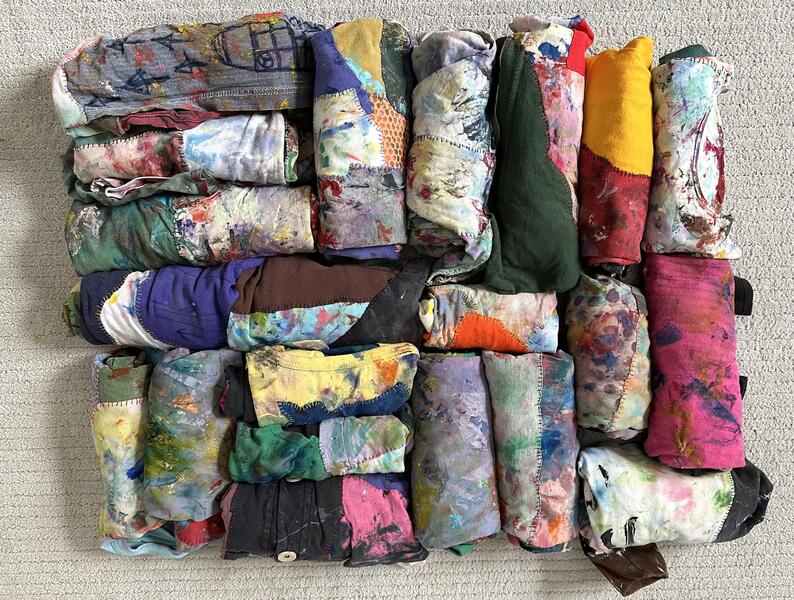 Painting Rag Shirts Rolled Up
Painting Rag Shirts Rolled UpHere are some of the Rag Shirts rolled up for storage. They remind me of colorful sardines.
-
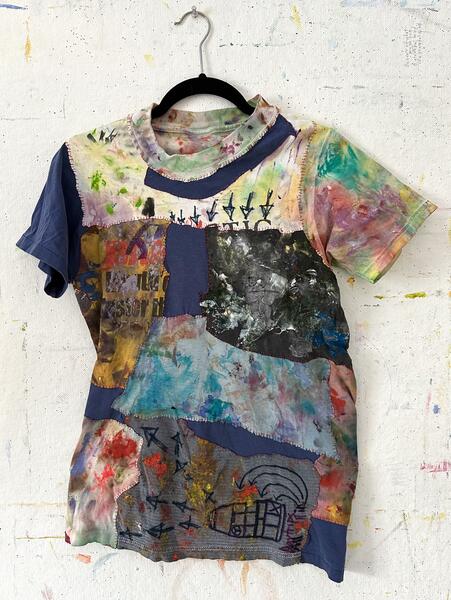 Mystic
MysticEvery once in a while, my family would pile into the station wagon and head to Mystic, Connecticut for a day trip. With 9 kids, there weren't enough seats so the 2 youngest sat sideways with legs overlapping in what was probably a storage area.
While making this shirt, I was remembering the times all 11 of us squeezed into whatever station wagon we had at the time. Assigned seating was the rule whether we were going to church or to Long Island to visit my mother's parents who lived in an apartment above a gas station, our two most frequent destinations.
I drew a seating chart map on the bottom of the shirt.
Remnants
Remnants is a visual diary of my studio practice and a living, endless loop of using, re-envisioning, transforming and reusing.
My art making process literally and philosophically involves putting pieces back together to create a more cohesive and loving whole. I envision it as a circle. My mixed media paintings are made intentionally. With every project, there are leftovers. Remnants is created from evidence of the creative process or, what’s left behind. The bi-product of each way of working becomes part of this cycle.
Remnants is an ongoing series. It is a cataloguing system I’ve been using for decades. (I love the Periodic Table and library cataloguing systems.) Remnants began because the little bits of dried paint, colored pencil shavings, painting rag scraps, thread ends, pencil nubs, and brush handles gathered together were too beautiful to throw away. As the tendrils of this series aged, I realized how important is to be aware of, not only my footprint in art making, but what I was de-valuing. This series represents what’s left behind and it has created itself.
As one example, I have a long history of painting over old paintings (some dating back to the late-1970’s and early 80’s), leaving traces of images seen and partly obscured. In tearing up some of the older paintings into tiles that are then attached to recent paintings, I am making old new again and compressing my art making timelines.
-
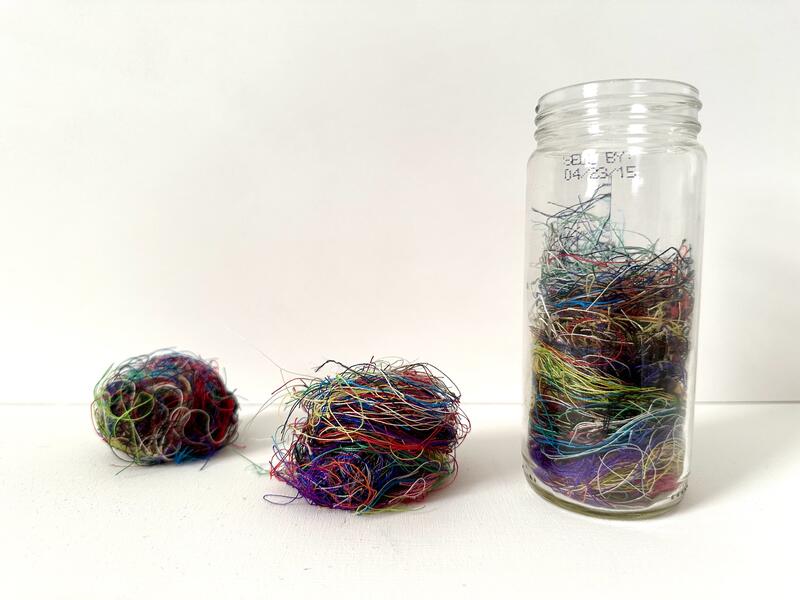 Thread
ThreadThese bits of thread are saved from making my hand-sewn figures. After being collected in a jar, the thread can be removed to resemble magical birds nests.
-
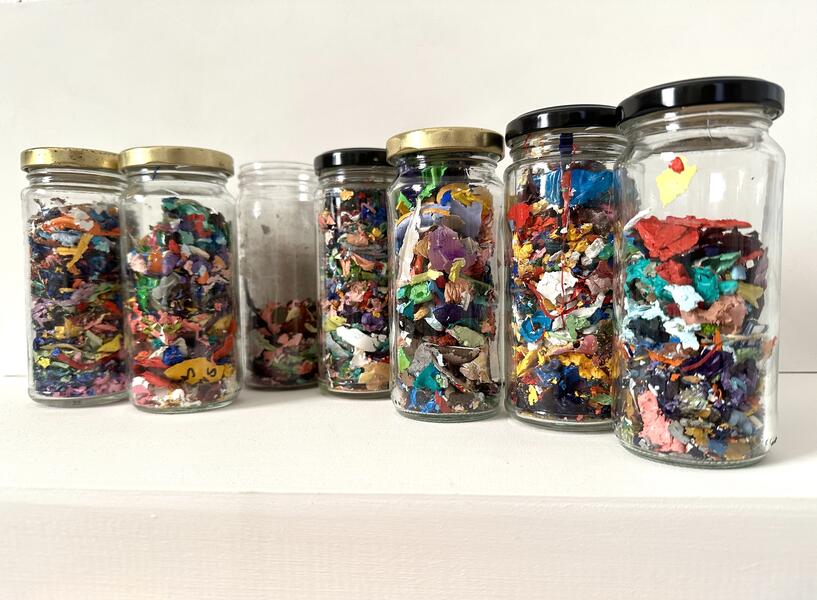 Untitled Dried Paint Bits
Untitled Dried Paint BitsEvery painter has paint that dries no matter how carefully you hydrate it. When I first started this series, I had a line of dried blobs that ran across my studio windowsills. The line became a cluster, then an unruly mound. After they went into jars, the began to remind me of stained glass, an important part of my childhood.
As my palette changes, the layers change. Now the jars line my windowsills.
-
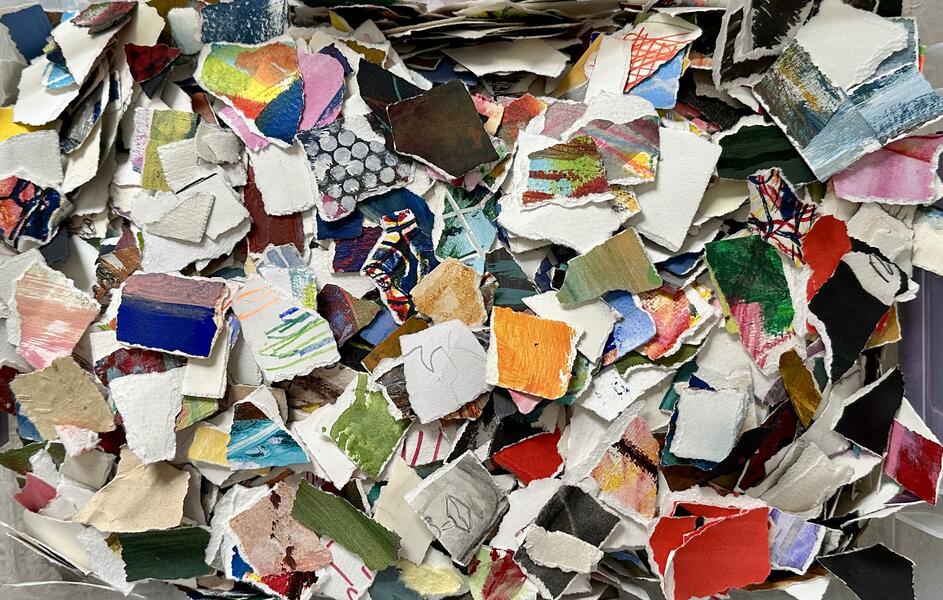 Torn Old Paintings for Tesserae
Torn Old Paintings for TesseraeI have a long history of painting over old paintings (some dating back to the late-1970’s and early 80’s), leaving traces of images seen and partly obscured. In tearing up some of the older paintings into tiles or tesserae that are then attached to recent paintings, I am making old new again and compressing my art making timelines.
-
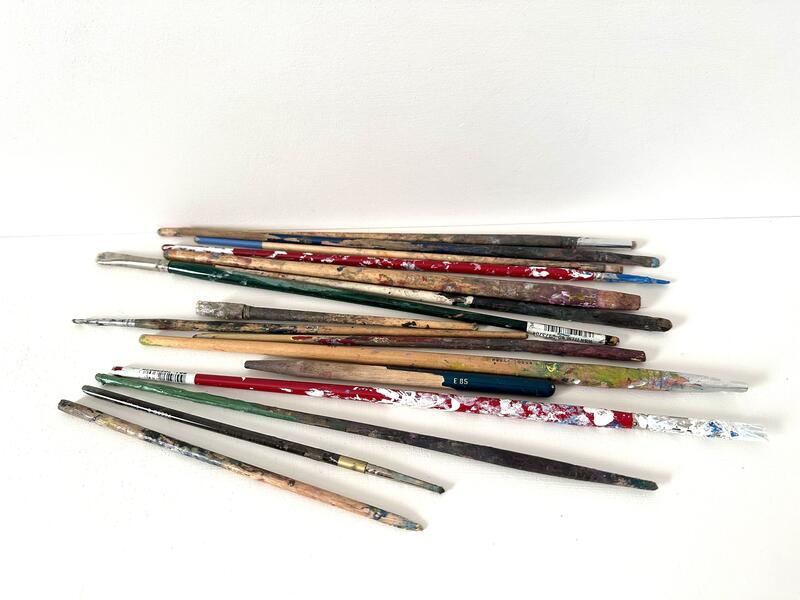 Paint Brush Handles
Paint Brush HandlesI don't often use quality brushes because my way of working tests them to their limits.My application is more scrubbing than brushing. I value a good sized brush with its overused, scary bristles because the marks made are unpredictable and exciting. Those brushes last a long time because I haven't ground them down. The smaller ones, pictured here, don't. For me, the handles and decimated bristles are evidence of good studio work.
-
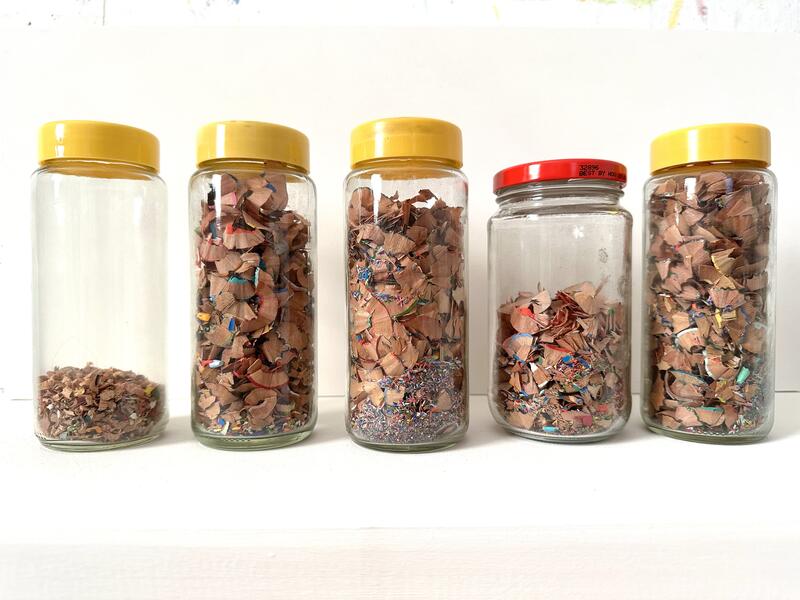 Untitled Pencil Shavings
Untitled Pencil ShavingsI love the process of sharpening pencils. It's grounding, purposeful and creates a beautiful by-product depending upon the sharpening technique. Sharpening with a blade leaves short, chunky bits, while a pencil sharpener creates slender, curved remnants. These shavings also call to mind stained glass windows.
-
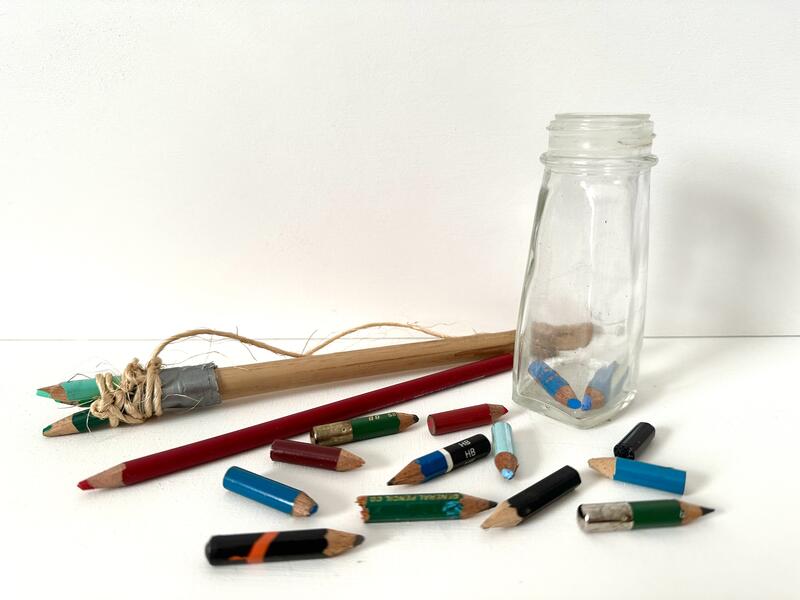 Almost Used Up Pencils
Almost Used Up PencilsDrawing was my first love as a child and it continues to be at the heart of my studio practice. I go through a lot of pencils, use them down to their absolute nubs, and can't bear to throw them away. Though I know pencil holders are commercially available, for some of my favorites, I've created unusual extensions.
-
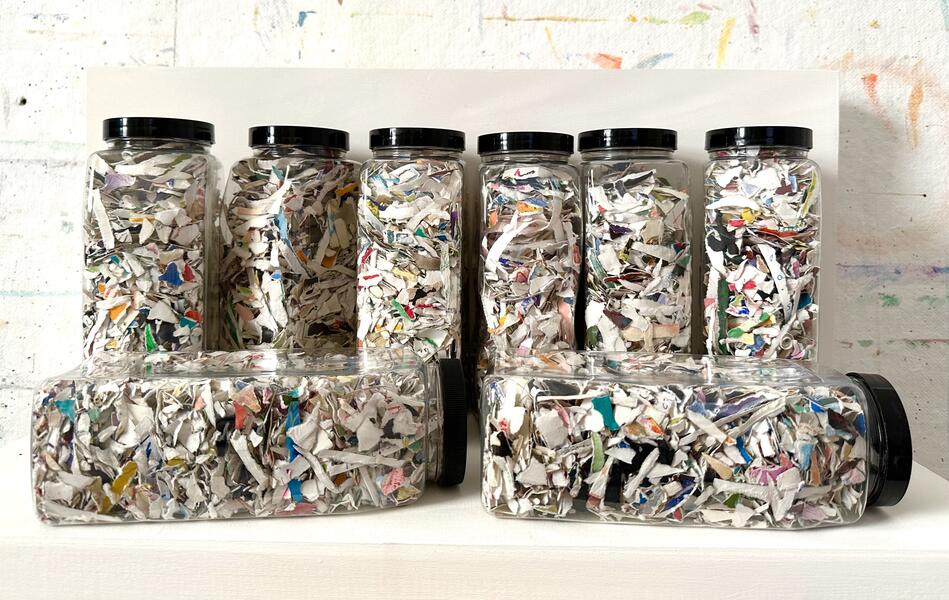 Torn Paper Remnants
Torn Paper RemnantsAfter old paintings are torn up to create arrows as prayers and tiles for collages, there are tiny pieces of old paintings leftover. As with the other media in the Remnant series, these jars are a history of my studio practice across decades. They may one day be a material for a new project.
-
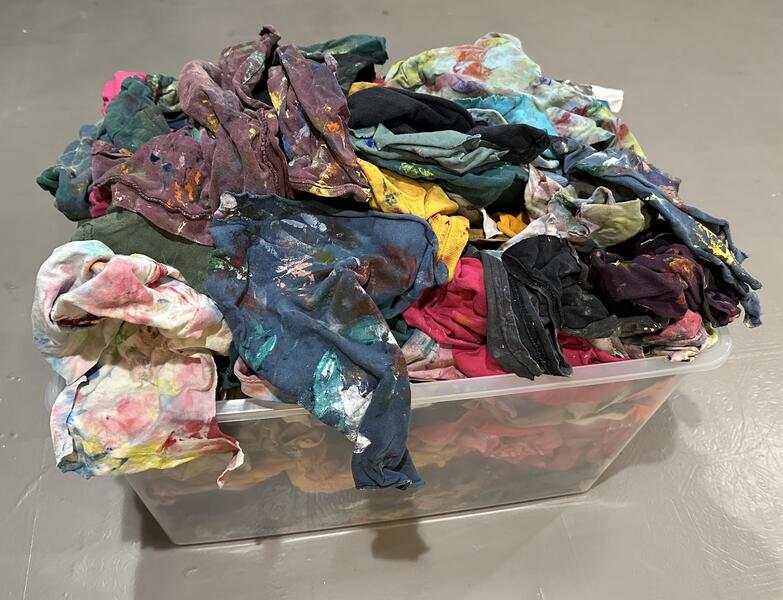 Painting Rag Scraps
Painting Rag ScrapsI never intended to start collecting my paintings rags in the mid 1980's but it happened. Cut from old T-shirts, I couldn't let go of the pieces, that resembled beautiful paintings in their own right. Initially, they were only my worn out shirts. In the mid 1990's, I added my husband and son's shirts too.
It took some years before I started piecing the rags together to create wearable hand-sewn painting rag shirts. I am still saving my painting rags and piecing them back together to bring the painting cycle full circle.
Forgetting Memory
My mother, a healthy and active 86 year-old, developed an infection which traveled to her brain. Overninght, she was completely transformed, bed ridden and frail. Initially, she was only able to say a handful of phrases which, strung together, seemed meaningless: “You know”, "Wow”, and “I was thinking “. Every once in a while she had moments of startling clarity.
In the next few months, she rebounded and learned to walk with a walker. Her ability to speak returned but her memory was dramatically impacted. She asked questions like, “Was I a good mother?” and “Was I a good wife?” She didn't remember all of her 9 children unless she named them from oldest to youngest. My parents had been married for over 50 years but she'd misplaced her memories of him. It was as if the files in her brain had been randomly ransacked and areas were deleted or mismatched.
In many ways, she was more content because she didn't remember what troubled her in the past. My mother became funnier, even to herself, asking questions like, “What do you call the thing with two holes?” I replied, “Pants?” She called her walker a wagon and most of the time was OK with her mix-ups. It was game we played of remembering and sometimes I got the answers right.
These drawings reflect the space between my mother's mind before and after, memory and forgetting, the frustration of losing something you can’t find again, and the playful moments that sometimes happen when loss is treated like an adventure.
-
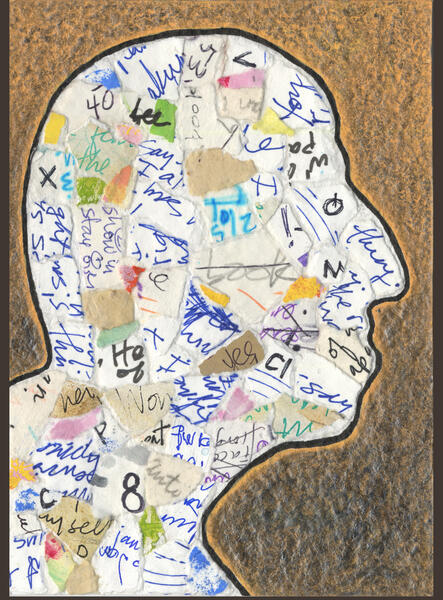 Chatter
Chatter -
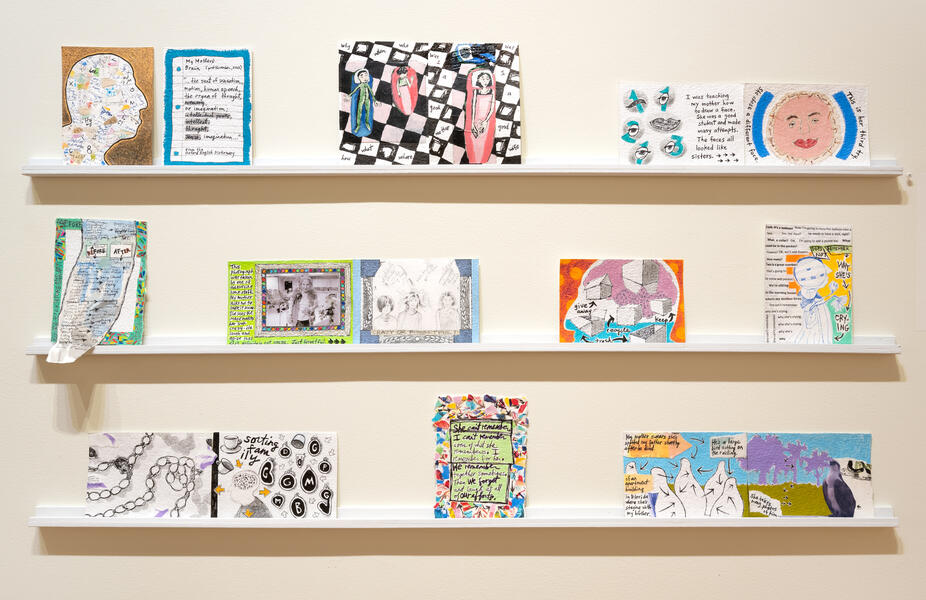 Forgetting MemoryForgetting Memory My mother, a healthy, active 86-year old, developed an infection which traveled to her brain. She was completely transformed, bed ridden and frail. Initially, she was only able to say a handful of phrases which, strung together, seemed meaningless: “You know”, "Wow”, and “I was thinking.” Every once in a while, she had moments of startling clarity. In the next few months, she rebounded and learned to walk with a walker. Her ability to speak returned but her memory was dramatically impacted. She asked questions like, “Was I a good mother?” and “Was I a good wife?” She didn't remember all of her 9 children unless she named them from oldest to youngest. My parents had been married for over 50 years but she'd misplaced her memories of him. It was as if the files in her brain had been randomly ransacked and areas were deleted or mismatched. In many ways, she was more content because she didn't remember what troubled her in the past. My mother became funnier, even to herself, asking questions like, “What do you call the thing with two holes?” I replied, “Pants?” She called her walker a wagon and most of the time was OK with her mix-ups. It was game we played of remembering and sometimes I got the answers right. These drawings reflect the space between my mother's mind before and after, memory and forgetting, the frustration of losing something you can’t find again, and the playful moments that sometimes happen when loss is treated like an adventure.
Forgetting MemoryForgetting Memory My mother, a healthy, active 86-year old, developed an infection which traveled to her brain. She was completely transformed, bed ridden and frail. Initially, she was only able to say a handful of phrases which, strung together, seemed meaningless: “You know”, "Wow”, and “I was thinking.” Every once in a while, she had moments of startling clarity. In the next few months, she rebounded and learned to walk with a walker. Her ability to speak returned but her memory was dramatically impacted. She asked questions like, “Was I a good mother?” and “Was I a good wife?” She didn't remember all of her 9 children unless she named them from oldest to youngest. My parents had been married for over 50 years but she'd misplaced her memories of him. It was as if the files in her brain had been randomly ransacked and areas were deleted or mismatched. In many ways, she was more content because she didn't remember what troubled her in the past. My mother became funnier, even to herself, asking questions like, “What do you call the thing with two holes?” I replied, “Pants?” She called her walker a wagon and most of the time was OK with her mix-ups. It was game we played of remembering and sometimes I got the answers right. These drawings reflect the space between my mother's mind before and after, memory and forgetting, the frustration of losing something you can’t find again, and the playful moments that sometimes happen when loss is treated like an adventure. -
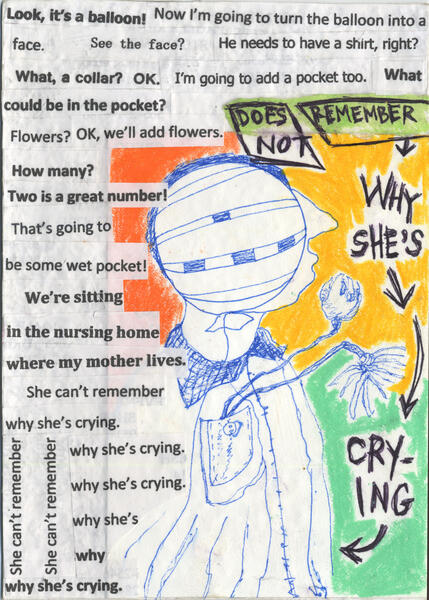 Forgetting Memoryfrom the series Forgetting Memory acrylic, marker, ball point pen and typed paper on paper 7"x5"
Forgetting Memoryfrom the series Forgetting Memory acrylic, marker, ball point pen and typed paper on paper 7"x5" -
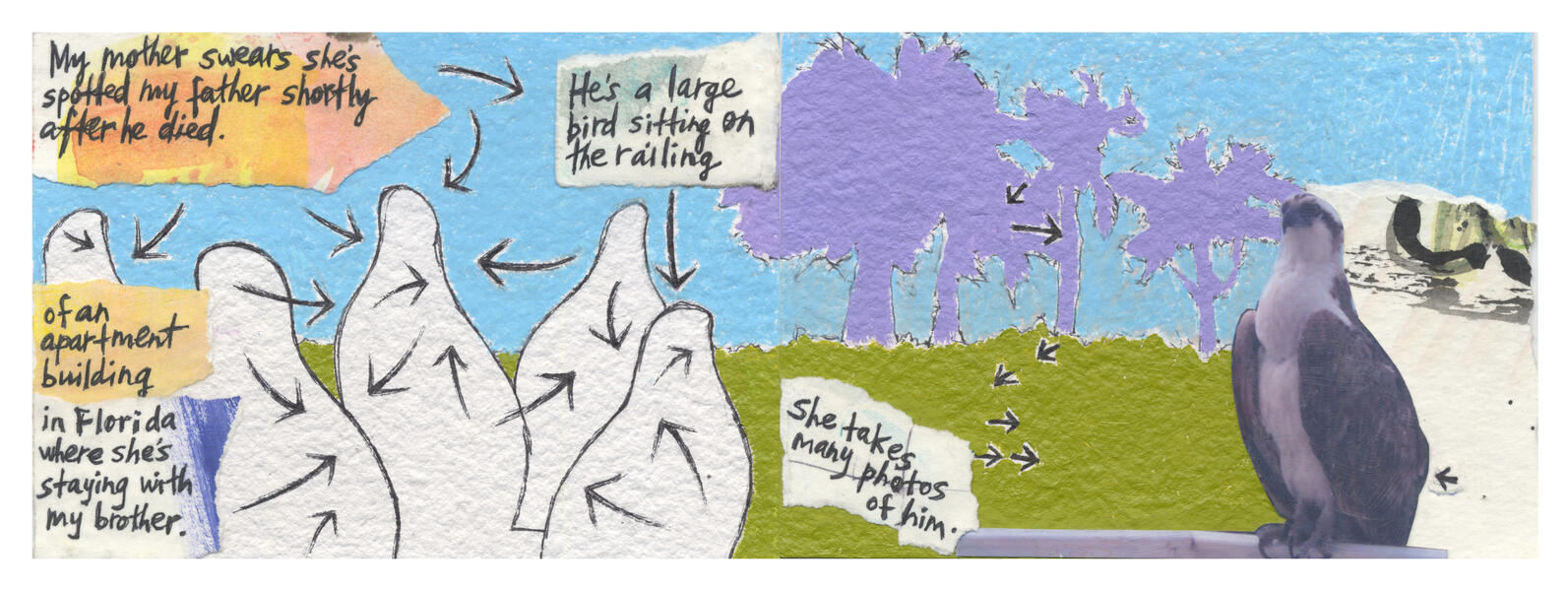 Bird Watchingacrylic, ink and photograph on paper 5"x14"
Bird Watchingacrylic, ink and photograph on paper 5"x14" -
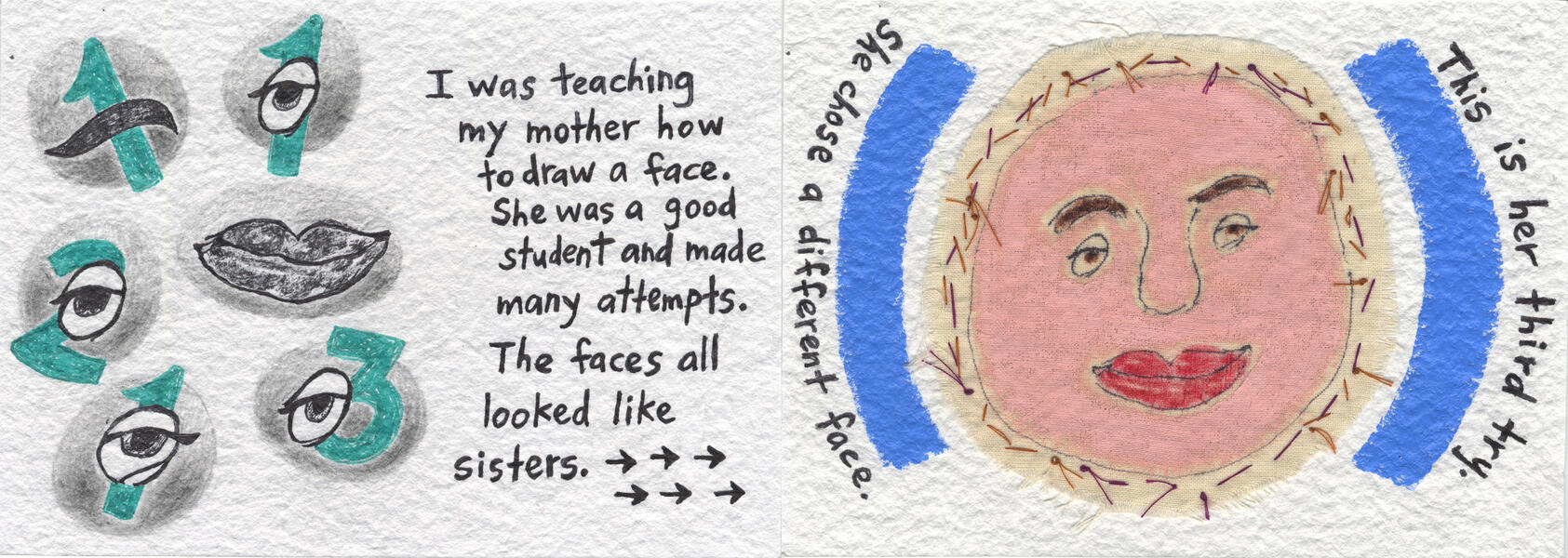 Sistersfrom the Forgetting Memory series 5"x14" acrylic, graphite, ink, thread, fabric on paper
Sistersfrom the Forgetting Memory series 5"x14" acrylic, graphite, ink, thread, fabric on paper -
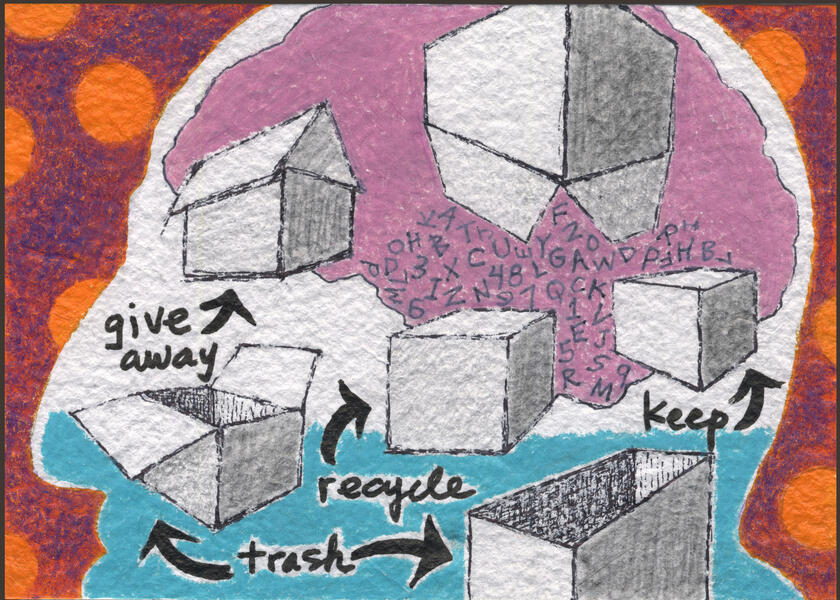 Packingfrom the series Forgetting Memory acrylic, marker and graphite on paper 5"x7"
Packingfrom the series Forgetting Memory acrylic, marker and graphite on paper 5"x7" -
 Questionsacrylic, ink and graphite on paper 10"x16"
Questionsacrylic, ink and graphite on paper 10"x16" -
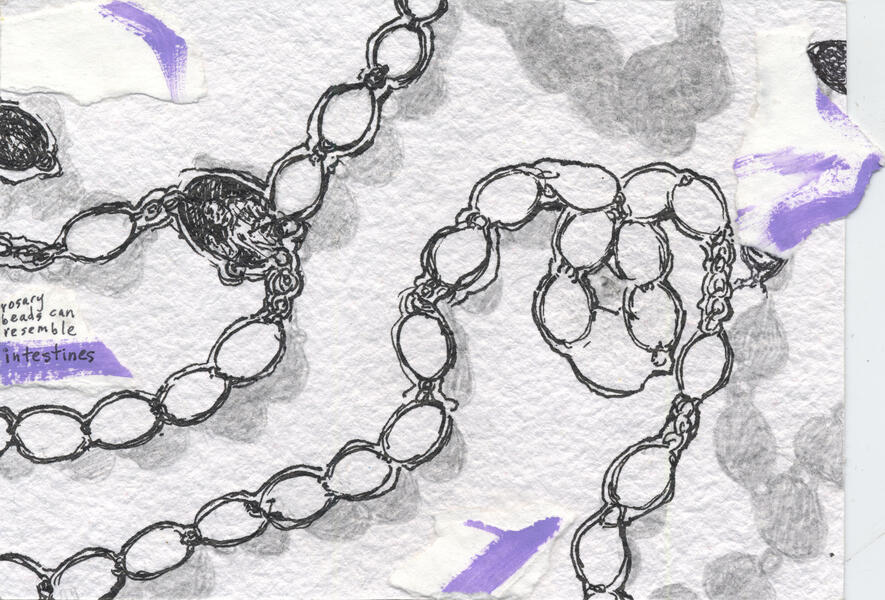 Beads
Beads -
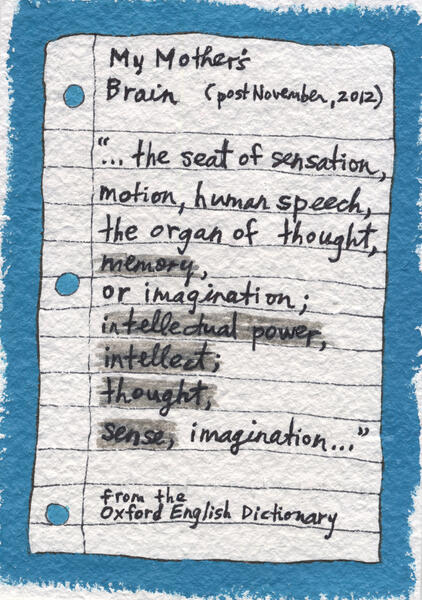 The List
The List -
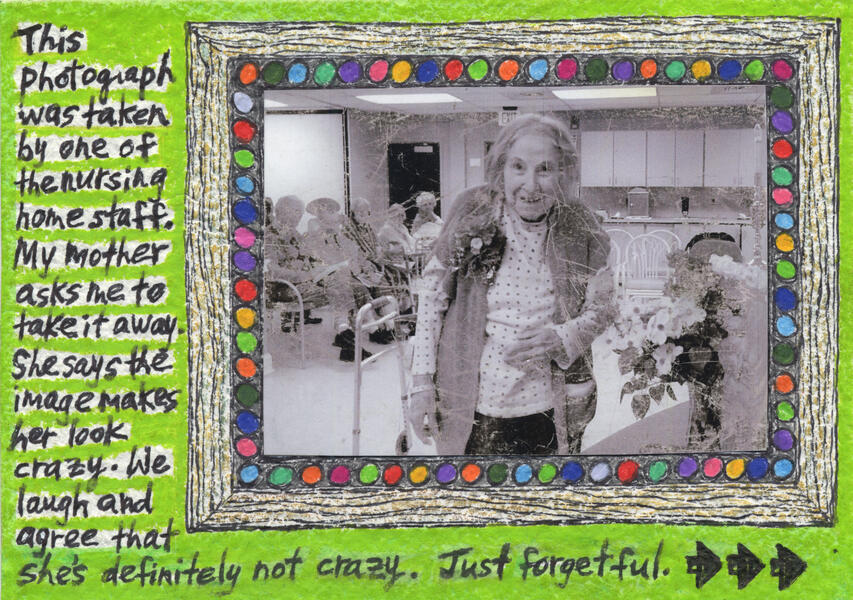 Crazy?
Crazy?
Statues for My Father
After my father died, my mother handed me a stack of his funeral cards and said, "Why don't you make something from these?" The cards honor his name (Gino Pierleoni, so close to mine), birth/death dates and the images and religious practice that was important to him. I wondered whether there would be a point during the alteration process when these religious figures might no longer be considered sacred. As the images transformed from Jesus, Mary and the Saints to become regular people, the images remained sacred.
The final pieces are mounted on wood, freestanding like statues.
-
 Daughter of the Lionsmixed media, torn paintings and to-do lists on paper mounted on wood approximately 9"x2.5"x1"
Daughter of the Lionsmixed media, torn paintings and to-do lists on paper mounted on wood approximately 9"x2.5"x1" -
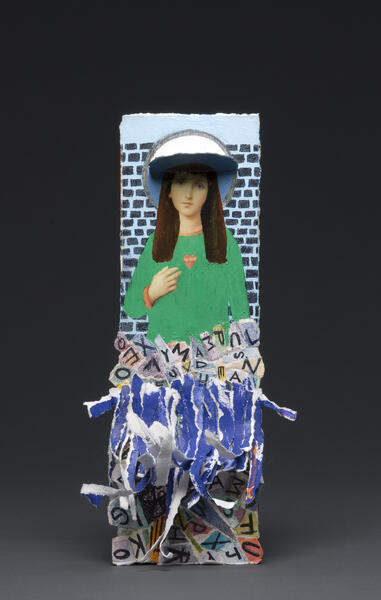 Modern Marymixed media on paper mounted on wood approximately 12"x4"x1"
Modern Marymixed media on paper mounted on wood approximately 12"x4"x1" -
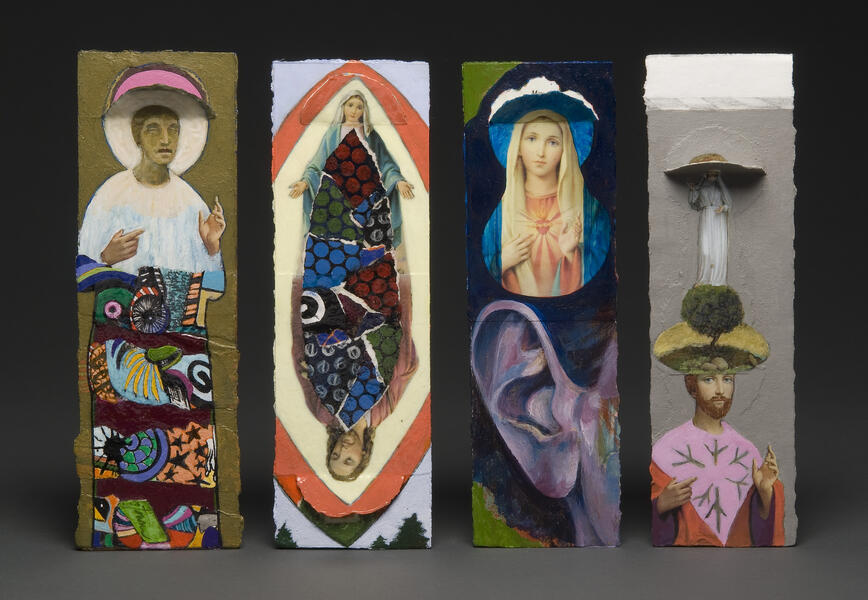 Four Statuesmixed media on paper mounted on wood Each statue is approximately: 8.5"x2.5"x1"
Four Statuesmixed media on paper mounted on wood Each statue is approximately: 8.5"x2.5"x1" -
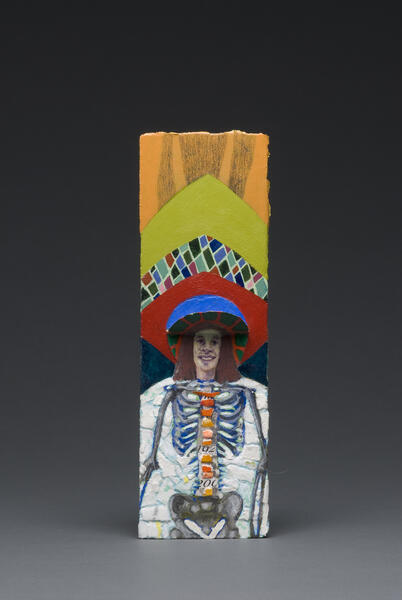 Self Portraitmixed media on paper mounted on wood approximately: 8.5"x2.5"x1"
Self Portraitmixed media on paper mounted on wood approximately: 8.5"x2.5"x1" -
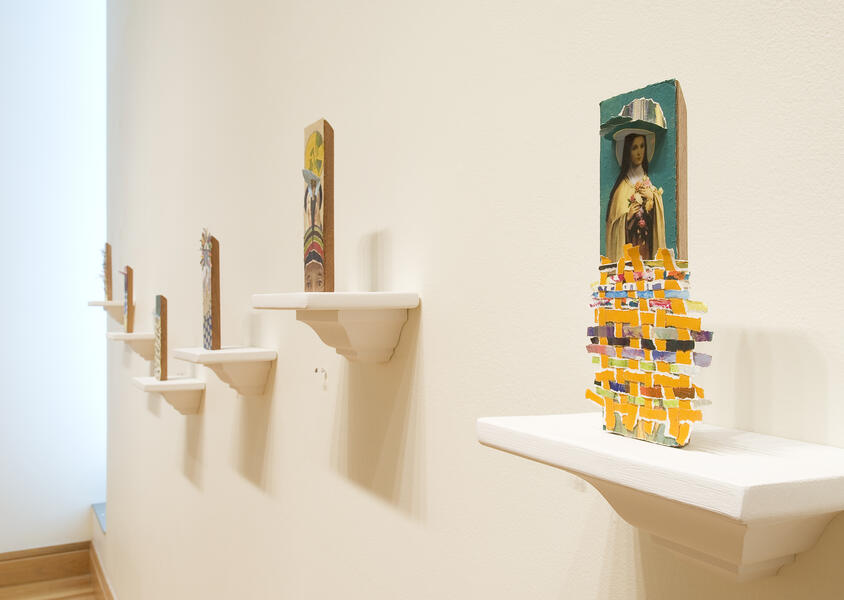 Statues installationStatue installation mixed media on paper mounted on wood and placed on shelves each approximately 9"x3"x1"
Statues installationStatue installation mixed media on paper mounted on wood and placed on shelves each approximately 9"x3"x1" -
 Do Not Look Outside Yourselfmixed media and torn paintings on paper mounted on wood approximately 10"x2.5"x1"
Do Not Look Outside Yourselfmixed media and torn paintings on paper mounted on wood approximately 10"x2.5"x1" -
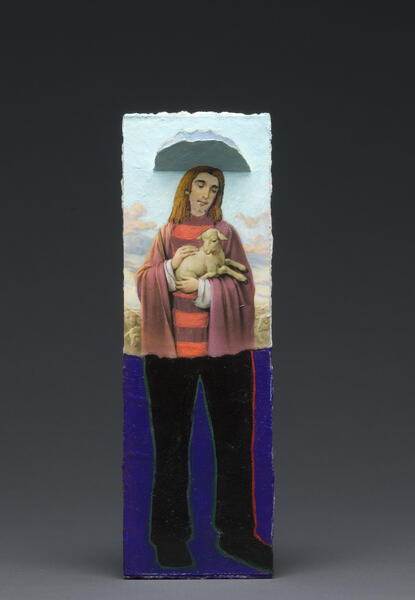 The Black Pantsmixed media on paper mounted on wood 8.5"x2""x1"
The Black Pantsmixed media on paper mounted on wood 8.5"x2""x1" -
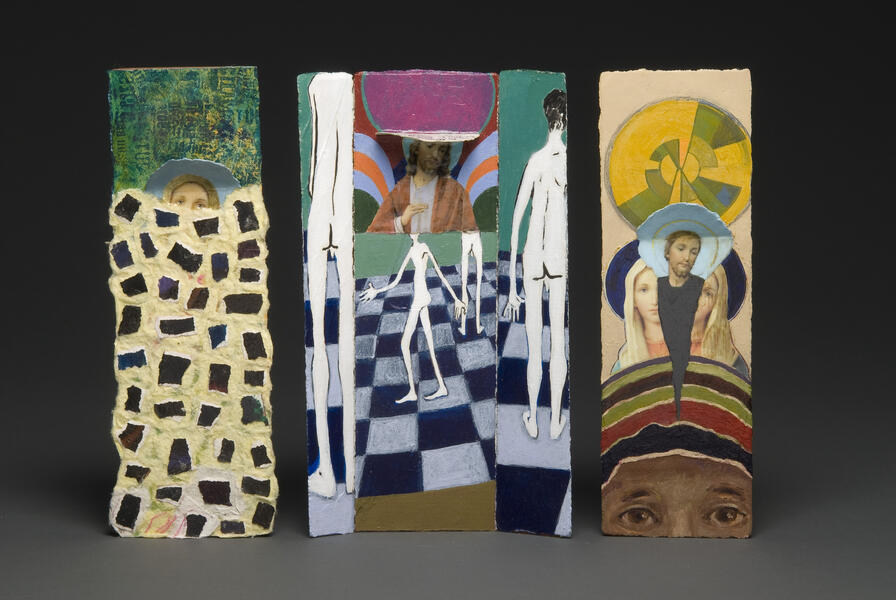 Three Statuesmixed media on paper mounted on wood End statues are approximately: 8.5"x2.5"x1"
Three Statuesmixed media on paper mounted on wood End statues are approximately: 8.5"x2.5"x1" -
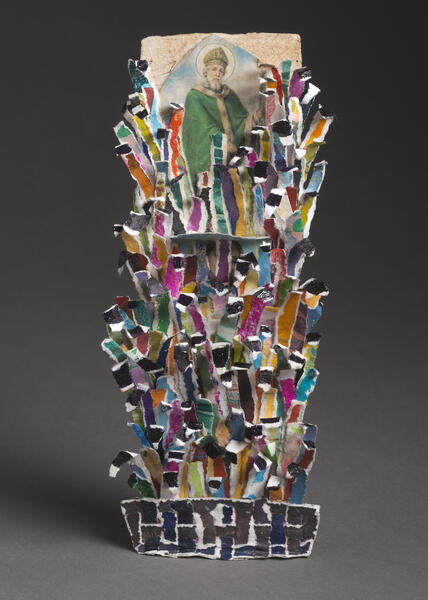 St. Patrick Pointingmixed media and torn paintings on paper mounted on wood approximately 10"x4"x1"
St. Patrick Pointingmixed media and torn paintings on paper mounted on wood approximately 10"x4"x1" -
 St. Theresamixed media and torn paintings on paper mounted on wood approximately 10"x2"x1"
St. Theresamixed media and torn paintings on paper mounted on wood approximately 10"x2"x1"





























































































